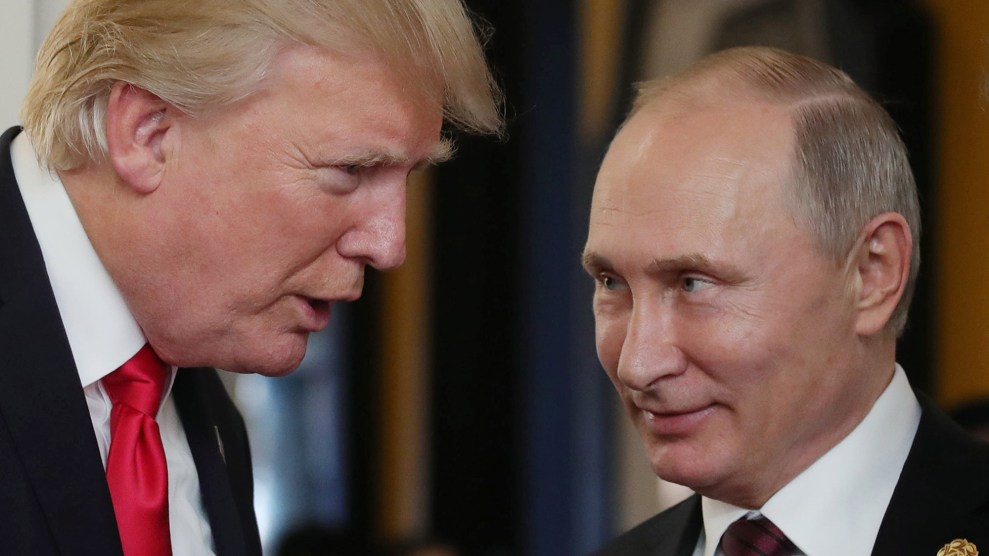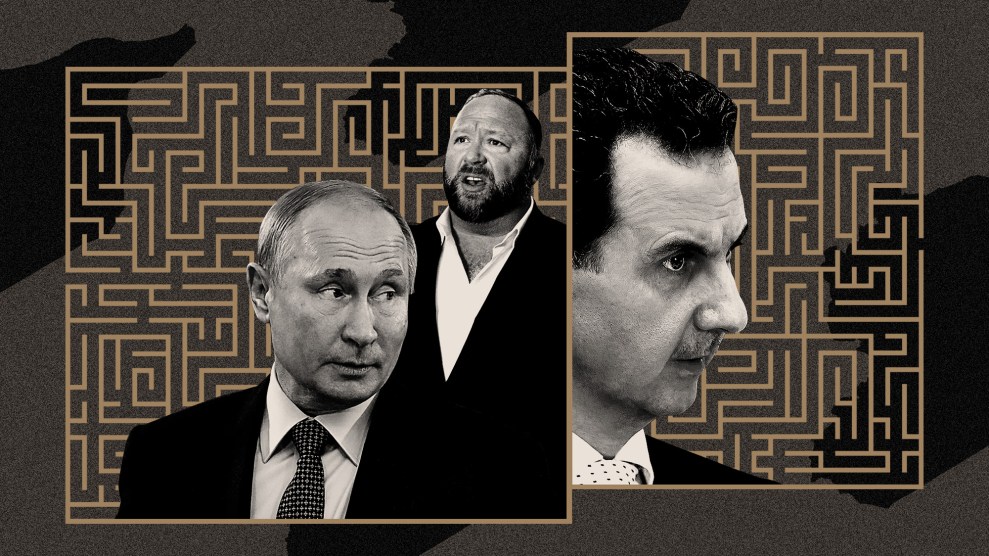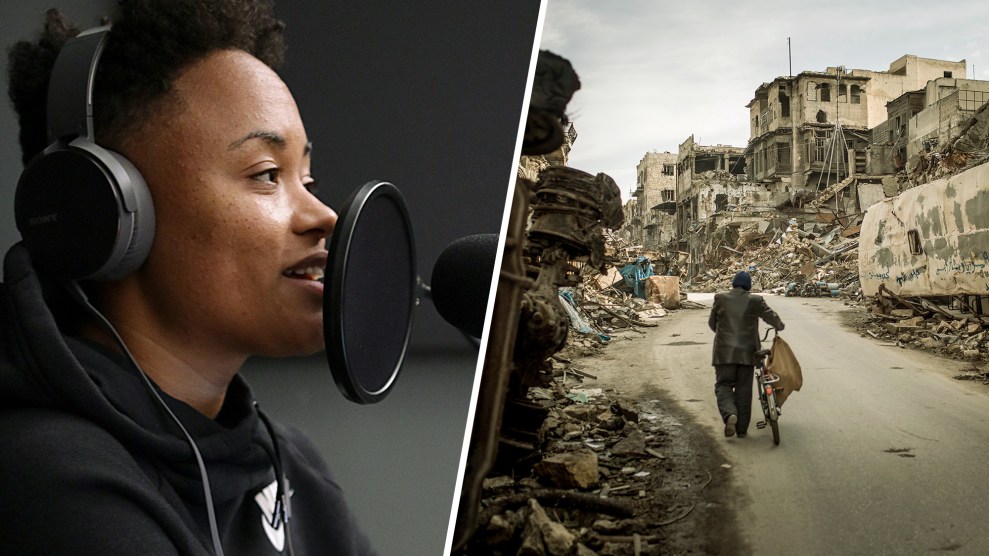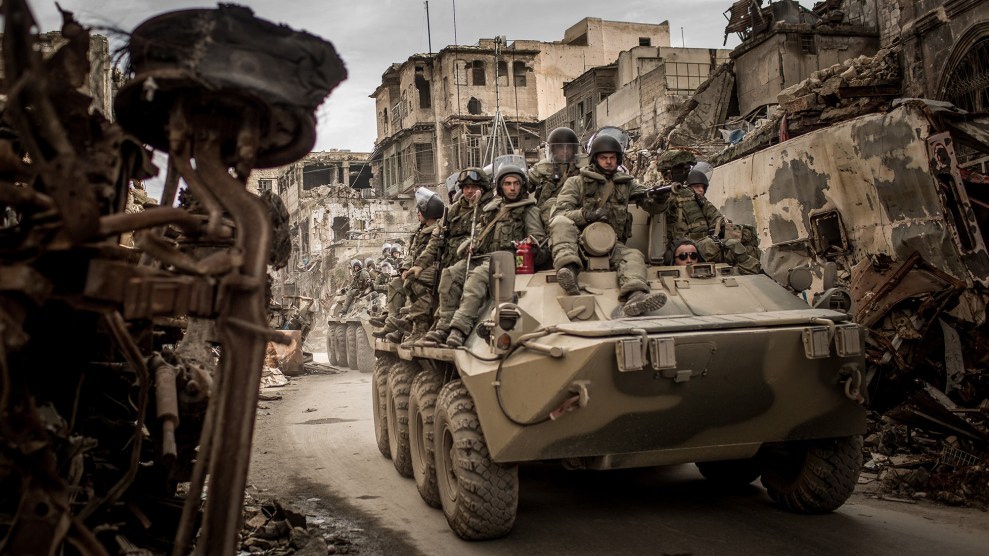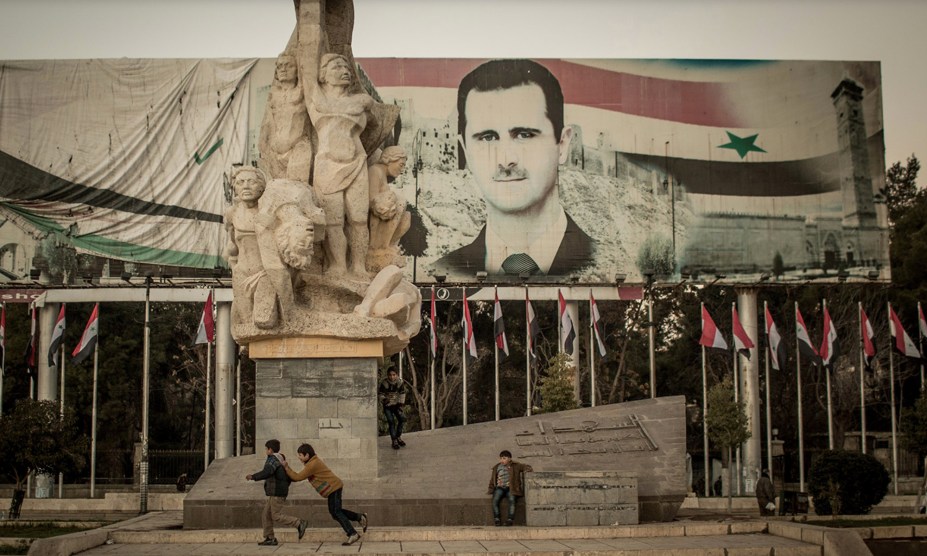An intelligence officer from the Kurdish women’s militia listens in to our conversation. Samantha Elhassani tells me she’s an American and a Christian and that she’d come from Indiana to Syria with her young son and daughter after her husband decided to join ISIS without telling her. “I was not aware we were coming to Syria,” she says. She lived under control of the Islamic State of Iraq and Syria for three years in Raqqa, where she had two more children. She survived the American-led assault on the city, escaped ISIS, and now wants to go home.
Samantha says her Syrian saga started around 2014. She was living near South Bend, Indiana, with her husband, Moussa, who had immigrated to the United States from Morocco about a decade earlier. “He was very American, nothing abnormal about him,” Samantha tells me. “He’s Muslim, I’m Christian. He never had a problem with anything I did. He drove a Porsche.” He wasn’t religious, she says. “He didn’t even grow a beard.”
When she couldn’t afford to get knee surgery, she says that Moussa suggested she get it done in Morocco. He also mentioned that houses were cheap and they should consider moving there. Samantha says she traveled to a pretty coastal town in Morocco where she found luxury apartments for sale for $30,000. She could imagine raising her one-and-a-half-year-old daughter and her seven-year-old son from a previous relationship there. By the time she got back to Indiana, she says, Moussa had put their cars up for sale and had sold their washer and dryer.
From here, Samantha’s story gets more bizarre. She says that as her family prepared to move, she made trips to Hong Kong, where she deposited cash in a safe deposit box to “evade taxes.” Then the family flew to Turkey—after stopping in Hong Kong to pick up their money. When they arrived in Turkey, Samantha was surprised to find one of Moussa’s brothers, Abdelhadi, waiting for them. Samantha says they traveled together to Sanliurfa, a city near the Syrian border, to visit a Muslim pilgrimage site.
When they got there, Samantha says, Moussa began acting strangely. He would go off with his brother all day, telling her to stay in their hotel room. After a week, Moussa told her to gather her things. The family got into a white van. Samantha says she soon realized they weren’t heading to the airport to go to Morocco. They stopped in the middle of nowhere, near a stretch of the Syrian border with heavy ISIS presence. Moussa grabbed their daughter and Samantha’s handbag, which held her passport and their cash. Then he walked toward the frontier. “Do I go or do I stay?” she asked herself. She grabbed her son, got out of the van, and followed her husband.
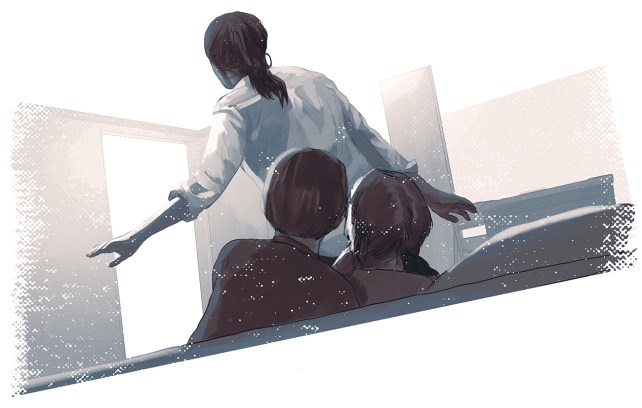
“If we survive this, we get out of here,” Samantha told her kids. “We go home.”
Owen Freeman
This story seems fishy to me. If Samantha couldn’t afford knee surgery, why was she flying around the world depositing cash? Did she really have no idea Moussa was planning to head into ISIS territory until this Sophie’s Choice moment?
Samantha is not the only American woman to have survived her time inside ISIS territory who now says she didn’t know what she was getting into. “Once I look back on it, I can’t stress how much of a crazy idea it was,” Hoda Muthana, a young woman from Alabama who’d run a pro-ISIS Twitter account from inside Syria, told the New York Times earlier this year. Kimberly Polman, who has American and Canadian citizenship, said she entered the Islamic State “as a humanitarian.” “How do you go from burning a passport to crying yourself to sleep because you have so much deep regret?” she asked. At least seven American women are known to have traveled to join ISIS and other jihadist groups in Syria and Iraq; at least 57 American men have.
Samantha has good reason to be cagey as she talks to me. Two months later, she was flown back to the United States, where she was charged with aiding her husband’s effort to join ISIS and providing material support to a terrorist group. Federal prosecutors have described her as “an adventure-seeker, prone to recklessness and…willing to lie and use people and relationships to advance her goals.” Many of the things she told me are contradicted by the government’s account of her journey. Prosecutors assert that Samantha told the FBI that Moussa had told her about his desire to join ISIS months before they went to Syria. When one of Moussa’s relatives in Morocco confronted her about her husband’s interest in ISIS, she allegedly said she would “follow him anywhere.”
Listen to “Behind the Lines,” a Mother Jones Podcast series. Shane Bauer reports from Syria on America’s role in one of the 21st century’s bloodiest conflicts. Episode One takes you to the former ISIS stronghold of Raqqa, where forensic teams conduct the harrowing work of uncovering thousands of bodies from the rubble.
Did Moussa trick or coerce Samantha to come to the Islamic State or did she come of her own free will? Sitting with her in the refugee camp, it’s hard to fathom what could have motivated her. She does not seem to be driven by religion, ideology, or any firm beliefs. Much of her account of her time in Syria is impossible to confirm, but it’s clear she wasn’t prepared for what she encountered.
She says that soon after her family crossed the Syrian border, she and her kids were separated from her husband. They drove to Raqqa, where she was confined in a house with women from France, Germany, and Arab countries while their husbands were taken off to training. The women scolded her for not praying. “Nobody knew that I wasn’t Muslim,” she tells me.
After three months in the house, she saw Moussa again. “I didn’t even recognize him,” she says. He was grimy, with a beard, a gun, and a huge smile. He hugged his daughter.
“I’m leaving,” Samantha told him. “You can’t keep us here.”
“You can try and go,” she recalls him saying. “But you’ll never make it.”
Moussa rented an apartment in Raqqa, then went off to fight. “I was terrified of living in this city,” Samantha says. “Terrified.” Armed men were everywhere. “These guys wearing long beards, and women in niqab, and everybody is just so angry.” After Moussa left, she bought a small house outside the city. “I moved as far away from the city as I could get to where there’s no security checkpoints.” When Moussa came back about a month later, he was mad that she hadn’t consulted him. Samantha told him that if she was going to accept her new life, she needed her space, and he relented.
Now that he was an ISIS soldier, Moussa “was confused on whether he wanted to die or if he wanted to live,” Samantha says. Should he be a martyr and go to heaven or live and provide for his family? In between his stints at the front, Moussa would try to make the family happy, bringing home a cat and taking them to restaurants selling Western food. He wanted her son, whom I’ll call Michael, to go to school, but Samantha refused and homeschooled him.
Samantha didn’t speak Arabic, but she would occasionally go to a neighbor’s house for tea. The neighbor was a smoker; cigarettes were banned by ISIS, so she thought she might be able to trust him. Eventually, she managed to communicate that she wanted to leave Syria with her kids. The neighbor said he’d arrange a smuggler. She prepared mentally for the journey, waiting for Moussa to return to the battlefield after he recovered from a mortar blowing up in his hand.
While he was recuperating, ISIS’s police broke down their door and arrested Samantha and Moussa. Apparently, her escape plot had been discovered. The police brought her to the Black Stadium, the soccer arena that ISIS had turned into its main prison in Raqqa, where she was held for two and a half months. A French woman, an Australian man, an Egyptian man, and a Syrian man interrogated her and pressured her to admit to being a spy, she says. She was told that Moussa was dead and her children had been sold as slaves in Iraq.
“I was tortured, I was beaten—just the sickest things that you could possibly imagine happened to me,” she recalls. “I was told that they were going to do everything to me that the Americans did to their brothers in Guantánamo Bay. You hear screams, you see blood on the floor. It’s all night: sleep deprivation, hunger, living in your own filth, regular beatings, the humiliation, electrocution. You stay in a cell that you can’t even stretch your legs in. There’s no toilet, there’s nothing. You just can’t imagine. They hang you up by the ceiling and they strip you naked and they beat you in front of a bunch of men. They take their imagination and they just roll with it.” Samantha was visibly pregnant. An Egyptian interrogator put cables on her belly and asked, “Does your child move when I electrocute you?”
In June 2016, as the Syrian army was attempting to take the city, she heard bombs falling around the prison. Suddenly, the ceiling of her cagelike cell fell in, busting the door open. She and other prisoners spilled into the streets. In the confusion, she spotted Moussa. She couldn’t believe it. “He looked like a walking ghost,” she recalls. They took cover and when the bombing ended, they ran. Then he stopped.
“We have to go back,” he told her. “They have to know you didn’t do anything wrong.”
It dawned on her that they had nowhere to go. The city was surrounded by checkpoints. If they went home, they would be arrested again and punished for escaping. They had fled one prison only to find themselves in a larger one. They went back and turned themselves in. Samantha says she was taken before ISIS judges, who said they would try to get her released. A few days later, she was dropped off on the street about a mile from her house. She was nine months pregnant, covered in scars, and she says she could barely walk on the leg her interrogators had fractured. Her kids, who had been passed between the houses of people she knew in Raqqa, were returned to her. Her son told Samantha that when he had asked about her, he was told that she was an infidel and that she had been killed.
In January 2017, Samantha posted on Facebook: “Just so everyone knows, I’m ok and my kiddos are ok 🙂 We are all doing just fine. I will get on soon and update everyone with a very public update about what’s up and I miss everyone so much. I love you guys!!”
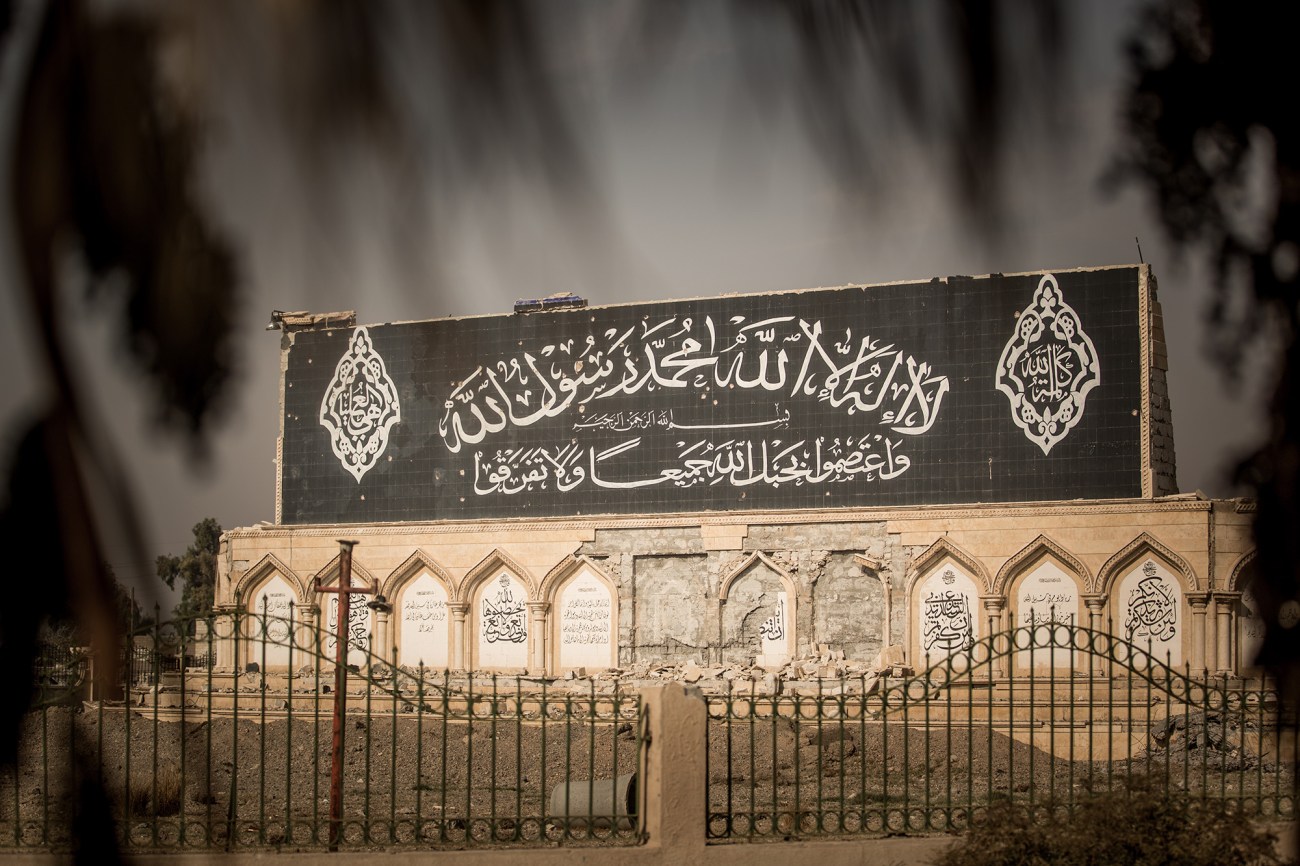
Religious inscriptions in Raqqa after ISIS was driven from the city
Christian Werner
After I leave Syria, I track down people who might know more about Samantha’s journey. “This is not a story of Syria,” Lori Sally Nishat, her sister and the ex-wife of Moussa’s brother Yassine, tells me. “It’s not about jihad—at all.” The stories I hear from Lori and other people who knew Samantha reveal patterns of attraction, abuse, and escape that would follow her to Syria. “This did not start in even the last 10 years,” Lori says. “This started way back when we were younger.”
I meet with Lori in South Bend, about an hour’s drive from where Samantha is now jailed. Lori tells me about their childhood growing up as Jehovah’s Witnesses in Arkansas and Oklahoma. Outsiders to the faith were kept at a distance. Their parents were not fond of public schooling and eventually homeschooled them. Their upbringing emphasized Bible study, worshipping God, and preparing for Armageddon. At one point, Lori remembers, their mother believed their house was possessed by demons. To fix the problem, church elders told the family to burn their videotapes of Dances With Wolves and Field of Dreams.
Samantha and Lori’s dad, who asked not to be named, doesn’t remember that incident. He was away from home a lot, driving trucks. But he does remember exorcising an apartment by burning a CD case with a picture of a deformed baby on it. “We never had no problems after that,” he says. He was strict, he admits, and sometimes he disciplined his daughters with a belt. Nevertheless, he insists that they “had a very good childhood…We had fun.”
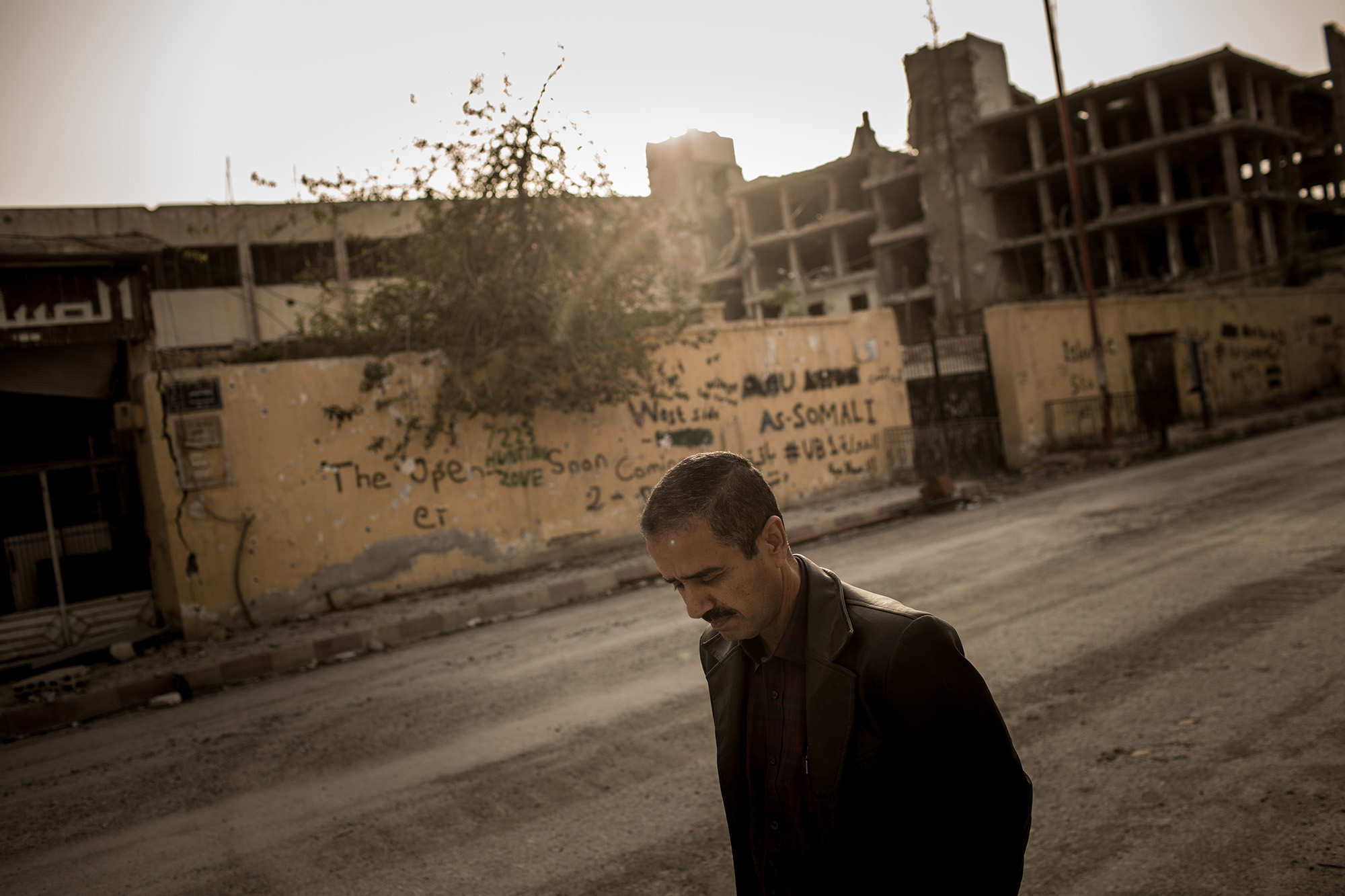
Lori remembers it differently. “We were supposed to be perfect little soldiers and stand in a straight line and just accept anything that came along,” she says. “We were taught [that there was] the world of Jehovah’s Witnesses and there was the world outside of it. Everybody in the world outside of it was in league with the devil, but anybody within the religion was your best friend. It did not matter who it was.” This, Lori believes, is partly how she and Samantha came to be sexually abused by a member of their extended family. Samantha and Lori’s father says he wasn’t aware of the abuse at the time, but says, “It breaks my heart that I did not protect my daughter.”
When Samantha was 16 or 17, she ran away with a twentysomething sailor she’d met online. Her father found her, brought her back to Arkansas, and told her, “I can do anything I want with you. If I want to go and get my gun and shoot you, I can shoot you.” He says he never intended to act on this threat, but he wanted to frighten her out of heading down a dangerous path. She married her boyfriend anyway. Her dad told Samantha he thought the guy was going to beat her, but “if that’s what you want to do, then that’s what you get.” Samantha’s dad, sister, and a childhood friend recall that her husband physically abused her.
Samantha divorced her husband and fell in love with an Iraq War veteran. Her life appeared to be falling apart. Lori remembers seeing Samantha one night looking “beat to hell.” She also recalls that some gang members punched Samantha in the face several times in front of her boyfriend and then raped her. Afterward, Samantha and her boyfriend went into hiding. (He did not respond to requests for comment.)
Samantha gave birth to Michael and split with the vet. In 2011, Samantha told Lori she wanted a new start. Lori told her to join her in Indiana, where she could set her up with a job with her in-laws’ international shipping company. But Lori warned Samantha: Stay away from her brother-in-law Moussa.
Lori worried that Moussa Elhassani was exactly the type of guy Samantha would fall for. He was young and handsome. He had a “silver tongue,” liked cocaine, and liked action. On one binge, he wrecked a Dodge Viper. “Moussa was very successful,” his father, Mohamed Almahdi Elhassani, tells me over the phone from Morocco. “He loved expensive cars.” Moussa worked for the family business, but Lori was trying to push him out. Employees had complained that he was trying to sell them coke and that he had sexually harassed a teenage employee. When the girl’s boyfriend confronted Moussa, Moussa held a hunting knife to his throat and slashed his car tires. Lori fired Moussa several times, but he kept coming back.
Within a month of arriving in Indiana, Samantha started dating Moussa. They were married in 2012. Court documents say Samantha “has consistently described Moussa prior to Syria as a loving, dedicated father and husband, who spared no expense for his family, showered her with jewelry and cars and treated [her son] as his own son.” But according to people who knew Samantha and Moussa, their relationship quickly went bad. AJ Moring, a childhood friend of Samantha’s who worked at the shipping company and lived with the couple, says Moussa hit Samantha and sometimes took away her keys and credit cards so she couldn’t leave. Moring says Moussa would go on cocaine binges and barricade himself and Samantha in their house. Both Lori and Moring recall that Moussa once tried to tear off Samantha’s clothes, telling Michael to grab a pair of scissors so he could “finish the job.”
Moring says Samantha told him that Moussa had threatened to kill her if she ever left. Lori tells me Samantha gave her three expensive watches to hang onto “in case she ever needed to escape.” But Samantha also protected Moussa. Samantha filed a restraining order against Moring after he confronted Moussa about his abusive behavior. Lori recalls a time when Moussa threw Samantha and her son out in the cold. She convinced Samantha to leave town, but then Moussa called and begged Samantha to come back. She relented.
Moring says Samantha started abusing hydrocodone. Lori recalls seeing needles in her house. Federal prosecutors say Samantha has acknowledged that she and her husband abused drugs.
The shipping company’s warehouse manager, Angela Benke, tells me that Moussa was packaging gun parts and marking them as toys before sending them to other countries, particularly Turkey. Lori says she reported the shipments to the FBI, and she and other employees say law enforcement seized some of the packages. Samantha also talked to the FBI, according to Lori and their father. In a hearing last year, one of Samantha’s lawyers said she had spent two years as a paid informant for the agency, providing the serial numbers of cellphones shipped to Yemen. Federal prosecutors confirmed that she was a confidential source for the FBI before she left for Syria. They didn’t specify the nature of her work, but they said it was not part of a terrorism investigation.
In 2012, Lori quit her job and divorced her husband, who had been charged with domestic battery. In a written statement, Samantha told the prosecutor that he was “being played” by Lori, who was a “scorned woman with delusions of getting even.” Samantha also testified that her sister was “not truthful” and that she bruised easily. Yassine was acquitted. (He pleaded guilty in a subsequent case. He did not respond to requests for comment.) The sisters stopped talking.
Then, in early 2015, Lori heard that Samantha and Moussa were selling everything, including their cars and house. Their neighbor told Lori that Moussa had showed him gold bullion in the back seat of his car. According to federal prosecutors, Moussa bought more than $60,000 worth of precious metals and melted them down in the company warehouse with Samantha’s help. Samantha pulled Michael out of class; the school was told they were moving to Mexico. Prosecutors say Samantha also lied to Michael’s father, saying she was taking him on vacation to Paris. Samantha also allegedly lied about her travel plans to the FBI agents she’d been providing information to.
According to the government’s version of events, Samantha visited Morocco but never looked for houses there. Shortly after that, she took Michael to Hong Kong twice, depositing at least $30,000 in a safe deposit box. She then returned to Hong Kong with Moussa and her two kids. There she allegedly arranged to buy rifle scopes and image-stabilized binoculars. Then the family flew to Istanbul—along with Moussa’s brother Abdelhadi. They entered Syria sometime between April and July 2015, when ISIS was near the peak of its expansion, and more than a year after Samantha had told me they’d crossed the border.
According to his father, Moussa said he was being “targeted” for taxes and he wanted to live in an Islamic country where he wouldn’t have to pay taxes. Moussa also told his dad it seemed like the Islamic State was becoming a genuine caliphate, and he thought life would be better there. “We told him, ‘We will disown you if you go to Syria,’” his father recalls. Moussa told his dad he would not become a fighter; he’d merely be an administrative employee for the Islamic State.
When Samantha and Moussa disappeared, Lori didn’t have the slightest idea they had left the country. She figured they had ripped off a drug dealer. It wouldn’t have been the first time Samantha was on the run.
In early 2017, Samantha called Lori for the first time in two years to say she was in Raqqa. She phoned occasionally after that, but their conversations were furtive and brief. Lori asked Abdelhadi to send Samantha’s kids home, but he told her he would rather they died in the Islamic State than go back to America. Later, he said he would send Michael if she paid a ransom. Lori showed me what she described as a “proof-of-life picture” of Michael in Syria. It shows him holding a sign that says: “I miss you auntie Lori. Happy Valentine’s Day. February, 2017.”
Moussa grew hardened after being imprisoned by ISIS, Samantha says. He didn’t excuse the sexual abuse she’d been subjected to behind bars, but he said she deserved everything else she got. He began talking about wanting to buy Yazidi girls. ISIS had been selling members of the ancient religious minority as slaves since it captured thousands of them in Iraq in August 2014. Moussa decided to buy a 17-year-old girl. Then he bought a 14-year-old girl. After that, Samantha says she convinced him to pay $1,500 for a seven-year-old boy.
Samantha tells me she treated the children like her own. “They became my best friends,” she says. She taught them some English. “They called me Mom. We were very close. And they hated my husband. You can imagine why.”
When Moussa came home, Samantha says, he would tell her which girl he wanted for the night. Samantha would ask the girl to shower and put on nice clothes and would send her to Moussa’s room. “He would go in, and then he would leave. It was like a two-minute thing,” she says. “He wanted to have babies.” When one of the girls refused to shower, Moussa became angry and told Samantha to force her to bathe. “I’m like, I’m not going to make her do anything,” she says. He put the girl in the shower, stripped her, and beat her. “I cried,” Samantha tells me. “What can I do, you know?”
When Moussa was away, Samantha says, everything was different. “Whenever he would leave, we were all relaxed, and we could laugh and we would sing and we would have fun.” Their little house felt like a refuge.
But by early 2017, it felt like a real war was coming. Not far from Raqqa, the Syrian Democratic Forces, the Kurdish-led alliance backed by the United States, tried to seize Syria’s largest dam from ISIS. Raqqa residents, afraid the dam would break and flood the city, began to flee. Coalition jets bombed an empty building and dropped flyers that she remembers warned, “We’re going to do this to your city. Get out.” But the planes had also bombed the bridges across the Euphrates and there was no easy way out. “If we survive this, we get out of here,” she told her kids. “We go home.”
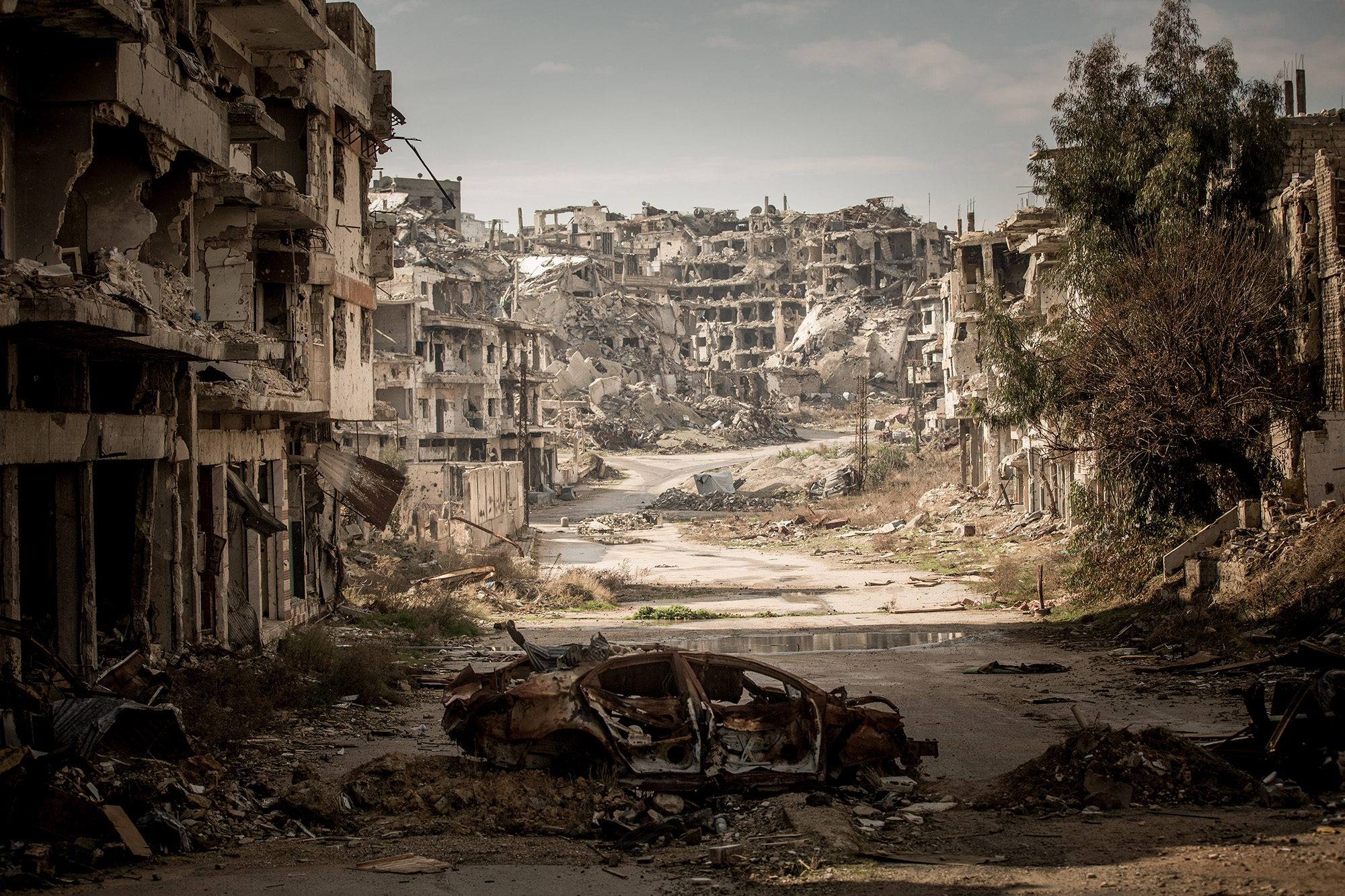
Homs, Syria
Christian Werner
As Kurdish forces approached, Moussa gave Samantha the keys to their car and told her to take the kids to an ISIS-held town in Deir Ezzor province, while he stayed behind and fought. She refused. Sticking out the US-led assault seemed like her best chance for getting out of the Islamic State, she tells me.
“You understand you might die here,” Moussa said.
“You understand I might die there,” she responded. “You understood this when you brought me here. Don’t pretend now you have some sort of respect of life.” If she left Raqqa, she thought, she’d still be trapped. In August 2017, she gave birth to her fourth child, a daughter.
During the battle, Moussa would disappear for a week at a time. “Any day, he’s going to die,” Samantha would tell the kids. “It’s inevitable. Just be patient.” In September 2017, Abdelhadi told her he’d seen Moussa get killed. She was relieved.
As she tells me about her efforts to resist Moussa, Samantha doesn’t mention one of the most troubling episodes of her story—one that the government would later present as evidence that she went along with her husband’s radicalization and that she would say is proof of how he coerced her. In August 2017, 10-year-old Michael appeared in an ISIS propaganda video. In it, he introduces himself as Yusuf. He says he is from the land of unbelievers, the child of “an American soldier who fought the mujahideen in Iraq.” When he and his mother came to the Islamic State, he says, they learned the “correct Islamic creed.”
“We live in a small city called Raqqa,” Michael recites. “This city has scared the whole world, because the Muslims who live in it have learned the meaning of jihad and have established the rule of Allah. Because of this, all the nations of the world who are led by America have gathered to scare us away from what we have established.”
He continues: “My message to Trump, the puppet of the Jews: Allah promised us victory, and he’s promised you defeat. This battle is not gonna end in Raqqa or Mosul. It’s gonna end in your lands. By the will of Allah, we will have victory. So get ready, for the fighting has just begun.” Michael is shown loading rounds into an assault rifle magazine. A man in a black mask shows him how to fire a sniper rifle. He is also shown playing with the Yazidi boy, who says, “We are like brothers.”
A couple of months into the coalition campaign, the bombardment intensified. “There was one day I think the hospital got hit with 700 rounds of cannon fire,” Samantha says. “Everything was destroyed.” Then, in October 2017, the bombing stopped. “I woke up one morning, there was no airplanes, there was no bombs,” Samantha recalls. “There was nothing. It was just quiet. We heard birds singing. It was amazing.”
Abdelhadi showed up and said he was taking her and the kids to a town near the Iraq border. When Samantha refused, Abdelhadi said he would take the Yazidi children and the three kids she had with Moussa. She could stay behind in Raqqa with Michael, but she said no. “The promises that I’d made, everything that had been done to survive at this point would have been undone. How could I just walk out with my son when I could’ve done that on the first day?” She agreed to go with her brother-in-law.
The SDF and the coalition had secretly agreed to allow ISIS fighters and their families to leave the city. Publicly, the SDF said only a few hundred unarmed fighters were let out, but Samantha says she rode in a convoy with “thousands of men, all armed.” (Shortly afterward, an SDF spokesperson who had defected to Turkey claimed 4,000 “terrorists” and their families had been allowed to evacuate.)
A couple of days after they reached their destination, Samantha says she befriended a man who said he could help them get out. The first smugglers he found backed out when they learned there were Yazidi children involved; ISIS’s purported penalty for smuggling a Yazidi to freedom was death. Through an illicit internet connection, one of the Yazidi girls contacted her uncle in Iraq, who then contacted the Kurdish YPG militia. In late 2017, Samantha gave a smuggler $10,000 and a Glock pistol to drive her and the kids into the desert where a truck was waiting for them. They were then taken to the Democratic Federation of Northern Syria.
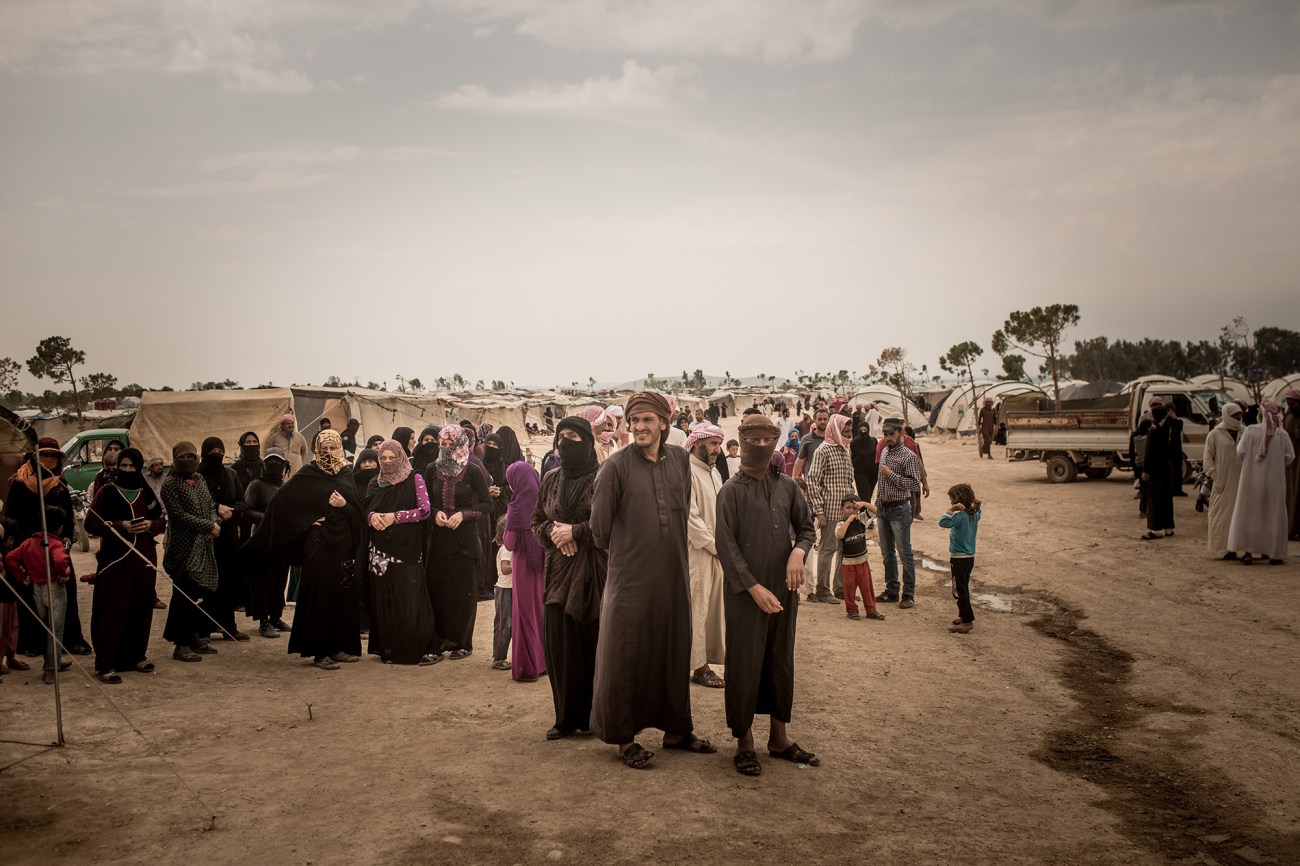
Refugee camp in the desert outside Raqqa
Christian Werner
FBI agents questioned Samantha while she was held by US-backed forces. She tells me the interrogations lasted for four or five days. On her last day of interviews, the agents told Samantha they were going to send her to a refugee camp. She begged them not to. “There are a lot of people who, especially if my husband’s brother is still alive, would see us dead,” she told them. The agents told her it wouldn’t be long; one said they’d get her out of Syria in just a few weeks.
When I meet Samantha in the camp in May 2018, six months have passed since she escaped the Islamic State. I ask her what she thinks will happen when she goes home. She’s not sure, but she says the FBI told her she would not face charges. Two months later, she was sent back to Indiana on a military cargo plane and brought before a federal judge. So far, she is the only American woman to have been charged with terrorism-related crimes after living inside ISIS territory.
The evidence against Samantha is sealed, but the government has argued that she knowingly assisted Moussa’s efforts to join ISIS and “willfully brought her children along for the treacherous ride.” In their petition for pretrial release, Samantha’s lawyers said she was “compelled, both psychologically and physically, to follow her husband’s and his brother’s absurd ideas” and that she had been traumatized by the torture and abuse she experienced in Syria. They argued that she had been a “hostage” in Raqqa and that she saved the lives of her four children and the three Yazidis. In a hearing last December, one of her attorneys, Thomas Durkin, accused the government of prosecuting another victim of her husband’s crimes. “When you’re married to a crazy man who abuses you and terrorizes you, you do what the crazy man tells you to do,” he said. “Everything that you’re looking at here has to be viewed through the lens of domestic violence and patriarchal abuse.”
Michael’s propaganda video is likely to be a key piece of evidence in her trial, as are two home videos obtained by the FBI. In one, according to a court document, Moussa tells Michael he’ll reward him with an explosive suicide belt if he can take apart an assault rifle. In another, recorded by Samantha, Michael puts together a suicide belt. Moussa asks him what he would do if the “American pigs” come for them. Michael explains how he would detonate the belt and become a martyr. Before her arrest, Samantha told CNN that Moussa beat her when she protested the making of Michael’s propaganda video. “He became very violent and scared my son into becoming complicit. I ended up with two broken ribs on that video,” she said.
The question of Samantha’s culpability will also hinge on the Yazidi slaves. Prosecutors have described her involvement in the purchase and supervision of the Yazidi children as part of her “horrifying conduct” in Syria. Durkin has called this claim “offensive.” “The big pig of a husband bought the Yazidi slaves and had sex with them in front of her,” he said in a hearing. “She had nothing to do with the Yazidi slaves other than to befriend them…She saved the Yazidis’ lives.”
The Yazidi kids rejoined their families in Iraq shortly after their escape from ISIS. When I contacted the Yazidi boy’s uncle, he said the boy “thinks about Sam and her children a lot.” One of the Yazidi girls sent a video message to CNN in which she attested to Samantha’s kindness, and said that Moussa had beaten Samantha for trying to protect her.
Samantha’s four children were put into state-supervised care. Michael’s father has requested to take care of him; her parents have also asked to care for her children. She has not been allowed to see her kids since her arrest. Her trial is scheduled to begin in January 2020. If she is convicted, she could be sentenced to more than a decade in federal prison.
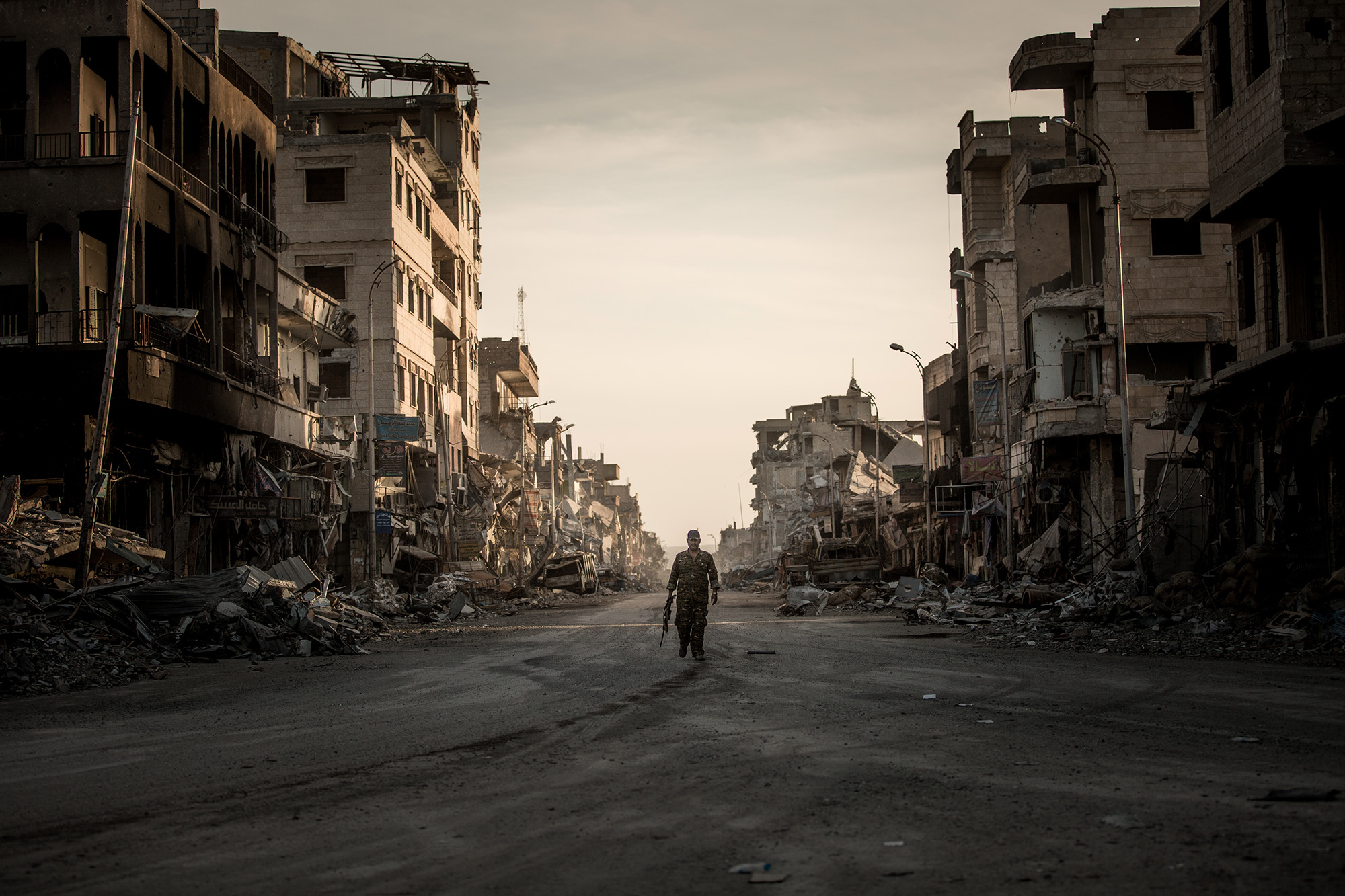
But what caught his eye were the TOW (tube-launched, optically tracked, wireless-guided) anti-tank missiles, the only American-made weapons in the load. Hamoud had been an anti-tank Specialist in President Bashar al-Assad’s special forces before he defected in 2012, and he had never seen these weapons in Syria before. The opposition occasionally captured Russian-made anti-tank missiles from regime troops or bought them on the black market for $110,000 each. If the CIA’s shipments kept coming, it would be the first steady supply of anti-tank weapons to the anti-Assad opposition. With these, they could hold back the regime’s well-equipped ground forces. It might even change the course of the conflict.
In the early years of the Syrian civil war, the CIA had assisted Saudi Arabia, Qatar, and Jordan in their efforts to arm the anti-government rebels. But in late 2013, the Obama administration decided to start sending weapons and ammunition directly. The CIA operation was dubbed Timber Sycamore. It would cost $1 billion, one of the agency’s most expensive programs since arming Afghan mujahideen in the 1980s.
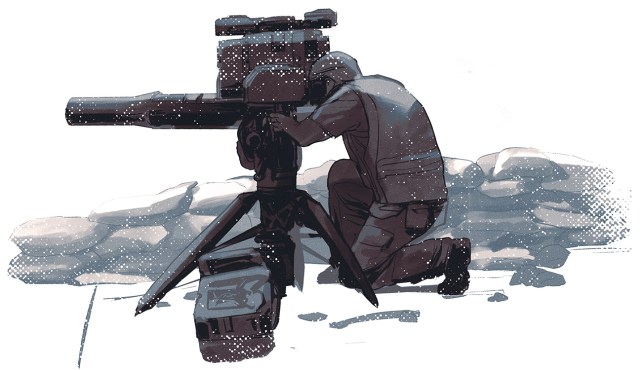
Hamoud used CIA-supplied missiles to take out Syrian government tanks.
Owen Freeman
Initially, the Obama administration had hoped the war would lead to what Alexander Bick, the director for Syria at the National Security Council, called a “wholesale renovation of the government,” in which Syrians friendly to the United States would come together to shape a new government in Damascus. But as the war expanded and more Islamist groups joined the opposition, that idea became “extremely worrying,” according to Bick. “We did not want a military victory by the opposition,” he recalls. Former officials say the White House hoped to press the Syrian government and the rebels into a stalemate, forcing them into UN-led negotiations in which the United States and Russia would have a high degree of influence. Until then, the United States would provide aid to the rebels, but it would also try to “fine-tune and calibrate the level of assistance to reach that magic temperature of just enough pressure but not so much that it actually spills over into victory,” according to a former senior State Department official with direct knowledge of the issue.
Many inside the government worried that aiding secular rebels would inadvertently benefit the Islamist factions springing up in Syria. In late 2013, what Bick called a “holy shit meeting” was held at the State Department to evaluate the growing relationship between the FSA and Al Qaeda’s Syrian affiliate, Jabhat al-Nusra. “Alarm bells were beginning to go off,” Bick recalls. The two groups seemed to be setting aside their ideological differences to team up against Assad, which complicated the American plan to arm the rebels. “If you’re going to give support to the opposition, you want to be confident that support is going to people that you trust,” Bick says. “You don’t want it filtering into terrorist groups”—or indirectly making them stronger.
Gradually, the Obama administration walked back its goal of speeding the end of the Assad regime, former officials at the State Department, the National Security Council, and the White House tell me. “The terms kept lowering from immediate departure of the entire regime…to a departure of just Assad and his cronies,” says Philip Gordon, the White House coordinator for the Middle East from 2013 to 2015. By the end of Obama’s second term, Bick says, “If Assad and a handful of his advisers had left and been replaced by an Alawite general chosen by Russia, the United States would have been willing to call that a political transition.” (Assad and much of his ruling clique are members of the syncretic minority sect known as Alawites; Syria is largely Sunni Muslim.)
Before equipping the rebels, the CIA joined several European and Gulf countries to establish two command centers in Jordan and Turkey, known as MOC and MOM, respectively. (MOC stood for Military Operations Center; the other went by its Turkish initials, MOM.) Through these centers, the United States and its allies would coordinate financial, military, and intelligence support for more than 100 rebel factions that had been vetted by the CIA. (The CIA declined to comment for this article.)
In 2013, Syrian rebel commanders consolidated their units to make arms transfers more efficient. Hamoud’s old group, the 9th Division, dissolved and merged with other factions to form the Harakat Hazzm, the Movement of Steadfastness. Other US-approved umbrella groups, including the Syrian Revolutionaries Front and the Southern Front, popped up. Fighters, including about 700 of Hamoud’s comrades, were flown to Qatar for training by the Americans to use the new weapons.
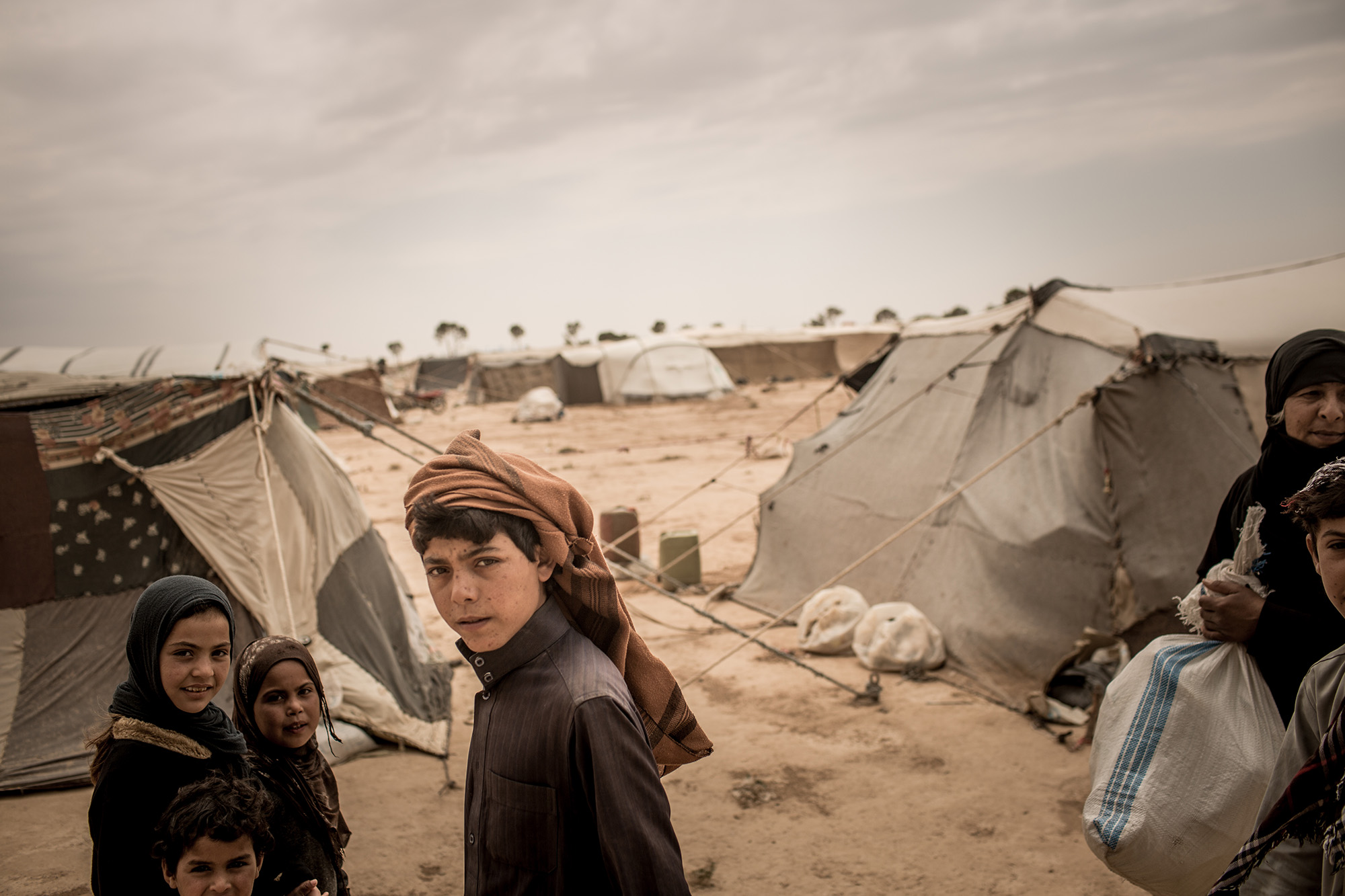
Given Hamoud’s experience as an anti-tank operator, his commander appointed him to operate their unit’s TOW missiles. But first the CIA wanted to vet Hamoud. The Americans were especially concerned about his longish beard. Beards are relatively common for Syrian men, but his handlers saw this as a potential indication that he was a religious extremist. (In fact, Hamoud had a reputation as a critic of jihadists; he would later survive an assassination attempt and was imprisoned for mocking Nusra on Facebook.)
Hamoud traveled to the Turkish border, where he met an American agent. To get a sense of Hamoud’s ideological leanings, the agent skimmed Hamoud’s Facebook account. He asked what battles Hamoud had participated in. Hamoud told him about a time he’d guided rebels and Nusra fighters on a raid of a government arms depot. He also mentioned his participation in a battle where the FSA and ISIS had worked together to seize a military air base.
The American was likely aware of that operation—its FSA commander, Abdul Jabbar Okaidi, was one of the main recipients of nonlethal aid from the United States at the time. The FSA had besieged the base for almost a year but wasn’t able to take it until ISIS sent in a suicide bomber. Upon capturing the base, Okaidi appeared in a video praising the ISIS fighters as “heroes.” He told a TV reporter that he was in regular contact with “the brothers in ISIS.” Robert Ford, the American ambassador to Syria when the war began, tells me he had scolded Okaidi for working with extremists. “How fucking dare you?” Ford recalls Okaidi responding. “You give us nothing to fight with. And now you are calling me and harassing me because I’m in a battle up to my eyeballs and I work with someone else who’s in the same battle. You have the balls to criticize and not give me help? Fuck you, Ford.” However, the FSA quickly turned on ISIS, and in early 2014, it drove ISIS out of northwestern Syria, where Hamoud’s unit operated.
Hamoud says his American screener met with him for 30 minutes and then approved him as a TOW operator. Back on the battlefield, Hamoud started taking out government tanks around Aleppo. He was so good at it that he was given the nom de guerre “Abu TOW.”
The CIA tried to keep close tabs on the groups it was arming. Hamoud and other FSA fighters tell me the Americans wanted them to take video of every missile launch. “Filming is more important than the target,” Hamoud’s commander told him. Another rebel commander tells me his brigade had to submit weekly reports on their operations and movements. FSA leaders say they were required to seek approval from the US-led command centers before launching new operations. American agents sometimes issued orders on when to attack or withdraw. If FSA commanders refused to obey, they could be sanctioned by receiving fewer supplies or being cut off entirely.
The command centers told fighters not to coordinate with Nusra, but despite the heavy monitoring, Hamoud says he continued to fight alongside the Al Qaeda branch. “I did not support Jabhat al-Nusra’s ideas whatsoever,” he says. Still, “we were in a war against the regime, and I was a TOW operator. I had to be at every active front to destroy the army’s tanks. I would go to any front. If there was a battle that Jabhat al-Nusra was participating in, I would still go. We have the same target.” Even if the CIA was aware of the ongoing collaboration between FSA and Nusra fighters, it still kept the arms flowing. Between 2014 and early 2018, Syrian rebels would fire at least 1,070 American-made TOWs, accounting for nearly two-thirds of all confirmed uses of anti-tank weapons by rebel forces. In total, Hamoud says he fired more than 130 TOWs; 128 hit their targets.
In June 2014, ISIS made a blitz on the Iraqi city of Mosul and declared the establishment of a caliphate, a quasi-state that encompassed 34,000 square miles between Iraq and Syria. Within two months, the United States began bombing ISIS in Iraq. In response, ISIS released a video of James Foley, an American journalist who had gone missing in Syria two years earlier. Foley was kneeling somewhere in the desert, dressed in an orange jumpsuit similar to those worn by accused enemy combatants held at the American prison in Guantánamo Bay, Cuba. Behind him stood a masked man dressed in black holding a knife. Foley gave a statement, presumably written by his captors. By bombing ISIS, Foley said, the American government had “signed my death certificate.” The man in black then beheaded him.
The video showed another kidnapped American journalist, Steven Sotloff, and the man in black said, “The life of this American citizen, Obama, depends on your next decision.” Two weeks later, Sotloff was beheaded. A week after that, in September, Obama authorized airstrikes against ISIS in Syria. It was the US military’s first intervention in the Syrian civil war. Obama promised he would not put American boots on the ground, a commitment that would be broken within a little more than a year.
The administration’s legal justification for military intervention in Syria was based on an expansive reading of the post-9/11 congressional authorization that allowed President George W. Bush to use military force against Al Qaeda, the Taliban, and other terrorist groups directly connected to the attacks. In the following decades, the Bush, Obama, and Trump administrations have cited the statute to justify military action not only in Afghanistan and Pakistan, but in Iraq, Yemen, and Somalia. Including Syria under this authorization was a stretch: ISIS was not part of Al Qaeda. In fact, in the months before Obama approved military action against ISIS, it had been at war with Al Qaeda’s Syrian branch, Nusra.
On September 22, 2014, the United States, with support from Saudi Arabia, Qatar, Jordan, the United Arab Emirates, and Bahrain, began bombing ISIS in Raqqa and Deir Ezzor. Some of the CIA-backed opposition fighters were outraged. Opposition groups had spent months asking the United States to set up a no-fly zone to protect them from the Syrian military, which had killed far more people than ISIS had. Now the Americans seemed to be indirectly helping Assad by attacking one of his enemies. The Hazzm Movement called the strikes “an attack against our national sovereignty.” The 13th Division, another FSA brigade, said the strikes were “aimed at weakening the revolution…and strengthening the regime.”
The new campaign highlighted the contradictions straining the Obama administration’s Syria policy. Unlike the CIA and the State Department, the Pentagon and its allies in the White House weren’t focused on regime change. They were continuing the global war on terrorism launched nearly 13 years earlier and stamping out the newest incarnation of anti-American jihadism. In late 2014, the National Security Council circulated a classified memo outlining a new Syria strategy. It said that the United States would deescalate its war with Assad to prioritize the fight against ISIS, according to two officials who viewed the document. There “was a cold-eyed realization that a weak Syrian government would contribute to the spread of ISIS,” one of them tells me.
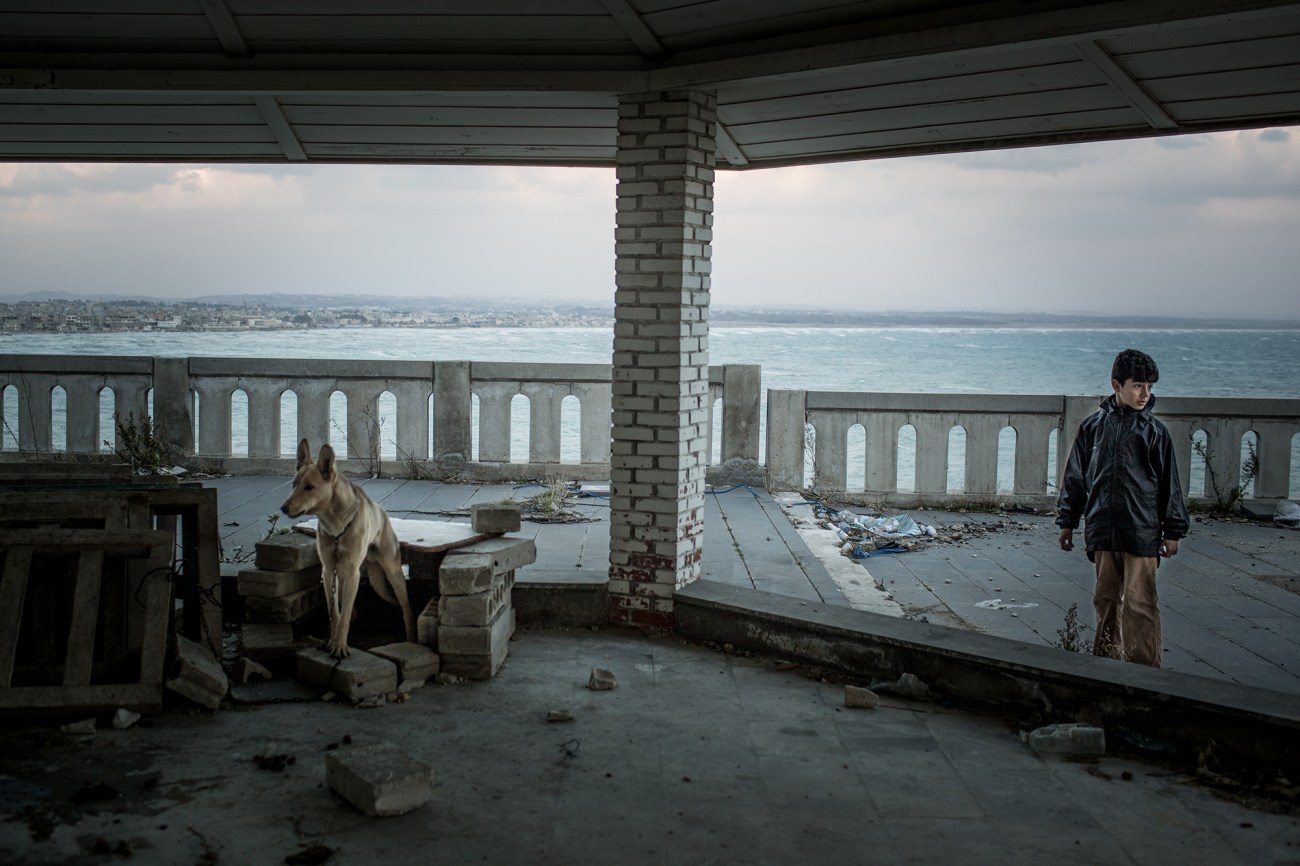
Coastal promenade in Latakia
Christian Werner
The expanded American war also fueled the growing divide within the Syrian opposition. Shortly after US airstrikes targeted an Al Qaeda–affiliated cell it was linked to, Nusra turned on American proxies in Idlib, in northwestern Syria. It captured villages and towns from two of the strongest CIA-backed brigades, the Syrian Revolutionaries Front and the Hazzm Movement. Nusra released images of what it said was an SRF warehouse full of food and other humanitarian supplies, adding to the rebels’ reputation for corruption. Jihadist media claimed that Nusra captured cannons, trucks, tanks, and at least 80 American-supplied TOW missiles. Nusra later posted photos of its fighters setting up the missiles. In early 2015, Nusra launched a new campaign against the Hazzm Movement, crushing it in just five days. Some fighters felt they’d been abandoned by the United States. As one FSA commander complained to me, “The Americans abandoned us, their allies. They left us to be killed by Nusra.”
The Pentagon also tried to raise a proxy force to fight ISIS. The $500 million Syrian Train and Equip program, started in late 2014, aimed to churn out some 5,000 fighters per year. One of those recruits was Mustafa Sejari, a former Islamist and the political leader of the al-Mu’tasim Brigade, a non-Islamist faction outside Aleppo. When he first met with the Americans, he assumed his brigade was being recruited to fight Assad. “We didn’t understand there was something called the Pentagon whose work is separate from the CIA,” Sejari tells me. “When we met with an American, we thought he represented the American point of view in Syria and we thought the Americans were against Bashar al-Assad.” Sejari says he was in Turkey for training when he realized his men would only be allowed to fight ISIS. “Anyone who wants to go off and fight other battles ends their relationship with the Pentagon immediately,” they were told.
The effort quickly fell apart. On multiple occasions, weapons meant for Pentagon-trained fighters were handed over to Nusra. “The opposition was more interested in fighting Assad than it was in fighting ISIS,” says Robert Malley, then–senior adviser to the president on the counter-ISIS campaign. After five months, the chief of US Central Command admitted to a Senate panel that just “four or five” trained fighters remained in the field. The Obama administration rushed to distance itself from the debacle. “Many of our critics had proposed this specific option as essentially the cure-all for all of the policy challenges that we’re facing in Syria right now,” said White House press secretary Josh Earnest. “That is not something that this administration ever believed, but it is something that our critics will have to answer for.” While the Pentagon would continue to work with rebels on the ground, it announced the end of this training program in October 2015.
As the Pentagon fought openly against ISIS, the CIA continued its covert operations against Assad. The CIA recruited FSA brigades operating along Syria’s Mediterranean coast and pressing on Latakia, the Alawite-dominated province that was the Assad government’s main base of support. One of them was the 10th Brigade, a scrappy faction that had been funded by private Saudi and Qatari donors. In February 2015, one of its field commanders, whom I’ll call Tannous, was invited to the MOM command center in a villa in southern Turkey. He was impressed by the huge screens connected to military satellite systems, and the large, detailed maps of opposition-controlled territory. He sat down with intelligence agents to discuss strategy.
Tannous and the Americans were already familiar with each other. He had rubbed shoulders with CIA agents when his brigade was part of the Supreme Military Council, a short-lived effort to unify the FSA command structure, backed by countries including the United States, Saudi Arabia, and Qatar. In 2013, the 10th Brigade had participated in a huge ISIS-led operation to take the coast from the regime. According to Human Rights Watch, fighters executed scores of civilians who belonged to Assad’s Alawite sect. Afterward, the 10th Brigade’s top commander gave ISIS ammunition, food, and money. Tannous says the CIA advised him to stop working with ISIS, but the CIA still reimbursed his brigade for the ammo used in the operation. After the FSA expelled ISIS from the area, the 10th Brigade coordinated with Nusra in a successful operation to take the coastal town of Kassab. As the jihadists advanced, they expelled the local Christian Armenian population.
The administration’s split Syria policy drove the CIA’s decision to continue arming groups that were entangled with the very extremists the Pentagon was at war with. “It was no secret that these groups that we were trying to back were working with Nusra,” Ford says. “Remember that the American objective was to get to a negotiation. It was very obvious Bashar al-Assad was never going to negotiate while he was predominant on the battlefield, so the Americans basically subordinated their concerns about the extremists and continued to help the moderates with the objective of getting Assad to make concessions and go to the table.”
Tannous says that during its seven-month relationship with the CIA and its Turkish hub, his brigade received 180,000 rounds of ammunition as well as weapons and wages. He admits that his brigade scammed its suppliers from the start. It claimed to have more than 400 fighters when it had fewer than half that. Altogether, Tannous says, there were no more than 1,000 FSA fighters on the coast, but the three local brigades receiving support from the Turkish command center reported more than 6,000 fighters. Bigger numbers meant more money: MOM paid about $100 a month in wages for a regular fighter and up to $1,200 for a top commander.
Tannous says his brigade also lied about what materiel it had so it could get more. “They’d give us the ammo,” he says. “We’d either sell it or give it away.” On one occasion Tannous saw his superiors trade a load of heavy machine-gun and anti-aircraft ammunition for $10,000 and a pickup truck. Mohammed Abdel Rahman, an administrative officer for the 10th Brigade, says he witnessed a commander give ammunition to a weapons dealer in exchange for a stack of cash.
Even as they courted the CIA, the 10th Brigade’s commanders felt they still needed to ingratiate themselves with Nusra, lest they meet the fate of the Hazzm Movement. Tannous says he and his comrades occasionally supplied Nusra with fighters and gave or sold ammunition from the 30,000 to 60,000 rounds they got from MOM each month. “It was a type of Arab hospitality,” Tannous says jokingly, “but on the Americans’ tab.” A source close to the 10th Brigade, who asked not to be named for fear of retaliation, tells me he witnessed a Nusra weapons buyer purchase large-caliber ammunition that the 10th Brigade had received from MOM.
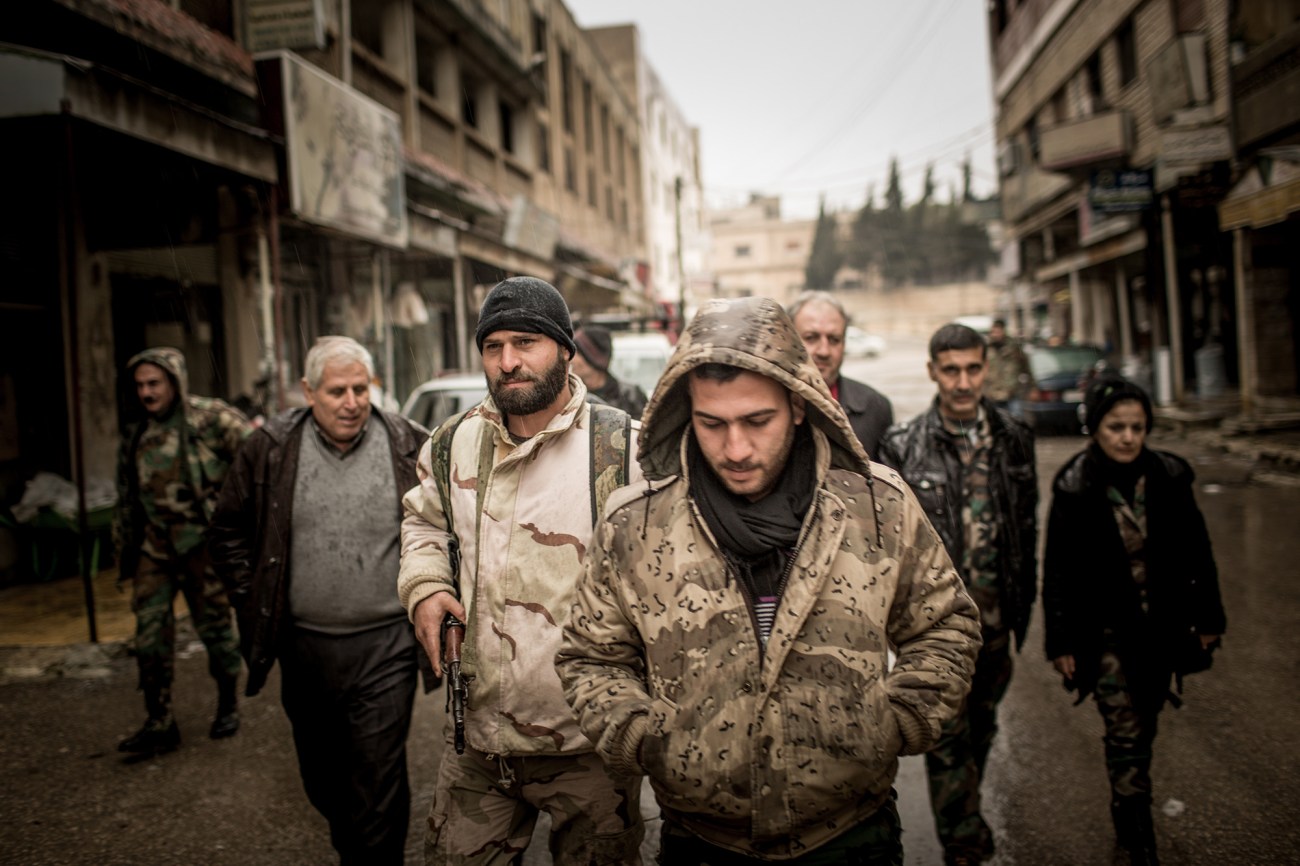
Militia on patrol in Masyaf, near Hama
Christian Werner
Tannous says he became frustrated with his superiors’ corruption and willingness to work with Al Qaeda, so he decided to raise the issue with their foreign patrons. “I wasn’t fighting a revolution so that ISIS or Nusra can rule us.” He says he met with a CIA agent in Turkey and showed her pictures of MOM-supplied ammunition being sold on the black market as well as a receipt detailing the sale of ammunition to Nusra. The agent told Tannous she would bring the information to her superiors, he recalls. Meanwhile, the monthly ammunition shipments continued, and the 10th Brigade and other CIA-backed groups continued joint operations with Nusra. In July 2015, videos posted on YouTube showed the 10th Brigade and Nusra celebrating a victory against regime forces in northwestern Syria.
In August 2015, the Turkish command center cut off its support to the 10th Brigade. The brigade then merged with Jaysh al-Sunna, a moderate Islamist group allied with Nusra. After that, it joined the Sham Legion, an Islamist alliance that had received funding, weapons, and ammunition from MOM, including TOWs.
Antitank missiles would prove crucial as the opposition gained ground in regime strongholds in the northwest. A senior State Department official attributed the opposition’s advances in part to its willingness to work with Nusra. The read in our situation room was, now things are finally starting to trend our way,” he recalls. But then Russia stepped in.
On September 30, 2015, Russian jets launched from an airfield in Syria blasted Nusra and CIA-backed groups that had been fighting side by side in Idlib. Russian President Vladimir Putin vowed to “fight and destroy militants and terrorists on the territories that they already occupy, not wait for them to come to our house.” In retrospect, Gordon says, the Russian move wasn’t a shock, considering the United States’ expanded involvement. “It was the logical continuation of what we had already seen, which is that the more that we intervene, the more they intervene,” he says. The war had turned another corner: It was now all but certain that the Assad regime would survive.
Inside the Obama administration, a consensus started to form on what Moscow’s actions meant for the future of the American role in the war. “Those people who had been arguing for a bigger, more direct intervention felt like, well, we have been checkmated,” the senior State Department official says. “Once the Russians intervened, the notion that we were going to be able to push Assad into his own demise, I think that went out the window, and so we basically adopted a totally different approach, with totally different objectives.” Other officials thought Russian intervention would prevent the Assad regime from collapsing and leaving a dangerous power vacuum; they also hoped it might dilute Iran’s influence in Syria.
Meanwhile, as the United States directed its attention to ISIS, Turkey presented an obstacle. The Americans had been sharing intelligence with Ankara about the flow of ISIS fighters and weapons across its frontier with Syria, and US officials had pressed Turkish President Recep Tayyip Erdoğan to tighten border security. “The Turks wouldn’t do anything,” a senior White House official involved in negotiations with Turkey tells me. “You eventually start to draw a conclusion that these guys are playing rope-a-dope and Erdoğan doesn’t really give a shit about ISIS.” While the Turkish government had no love for ISIS, it was reluctant to throw itself into the fight so long as ISIS’s territorial gains put pressure on Kurdish militants, Turkey’s longtime foe.
In September 2014, thousands of ISIS fighters assaulted the heavily Kurdish city of Kobanî, near the Turkish border. As ISIS took parts of the city, the YPG contacted Kurdish officials in Iraq, who reached out to their American military contacts to ask for weapons and aid for the Kurds. According to a senior White House official, Turkey opposed American support for the YPG’s defense of the city, but Obama convinced Erdoğan to relent. During the four-month battle, the United States dropped ammunition and provided air support to the Kurds until ISIS was forced to retreat.
Kobanî was the United States’ first clear victory in Syria, says Brett McGurk, the presidential envoy to the anti-ISIS coalition. And in the YPG, the Pentagon had found the local proxy force it had sought all along: The Kurdish fighters weren’t religious extremists; they worked well with Americans, and, unlike the FSA, they didn’t fight among themselves. Plus, they weren’t focused on defeating the Assad regime. But even after Kobanî, the idea of allying with the Kurds “was not a policy that was enthusiastically embraced,” says Malley. Turkey did not want the United States to create a Kurdish counter-ISIS force, but Obama eventually became convinced that an alternate, Arab-led “unicorn force” was not feasible, Malley says.
In late 2015, Obama sent about 50 special operators into Syria to train and coordinate with the YPG. In doing so, the United States was aiding not only an enemy of its ally Turkey, but an enemy of its FSA proxies. In early 2016, the YPG began attacking CIA-backed rebel factions north of Aleppo in an attempt to create a corridor connecting the isolated Kurdish region of Afrin to the rest of the Kurdish territory of Rojava. The fighting showed just how complicated the war’s conflicting alliances had become: In one town, US-backed opposition groups were simultaneously attacked by ISIS, the Syrian military, Russian jets, and the YPG. The US military, meanwhile, air-dropped ammunition to the rebels, and ISIS relented.
As Russia focused on hammering anti-Assad rebels in northwestern Syria, the military tide turned against the FSA and CIA-backed fighters. In December 2016, the rebel stronghold of Aleppo fell. In July 2017, President Trump officially ended the CIA’s Timber Sycamore program, which he described as “massive, dangerous, and wasteful.” Some of the US-backed brigades would turn to Turkey for support. According to Hamoud, Turkey supplied more TOW missiles, though it provided virtually no oversight on how they were used. In March 2018, Turkey seized Afrin from the US-backed Kurdish forces. It was aided by FSA brigades formerly backed by the CIA.
The costly secret war to weaken Assad was over. The Americans were now exclusively focused on ISIS—the one enemy shared by every major player in the conflict. Though the United States and Russia were officially on different sides of the civil war, they divvied up turf and set up lines of communication so their forces didn’t accidentally clash. If there could not be one clear winner, at least both countries might ensure that their main allies on the ground would not lose the war against the Islamic State. Russian planes would join Syrian jets in bombing Aleppo, eastern Ghouta, and Deir Ezzor. The United States would set its sights on the ISIS stronghold of Raqqa.
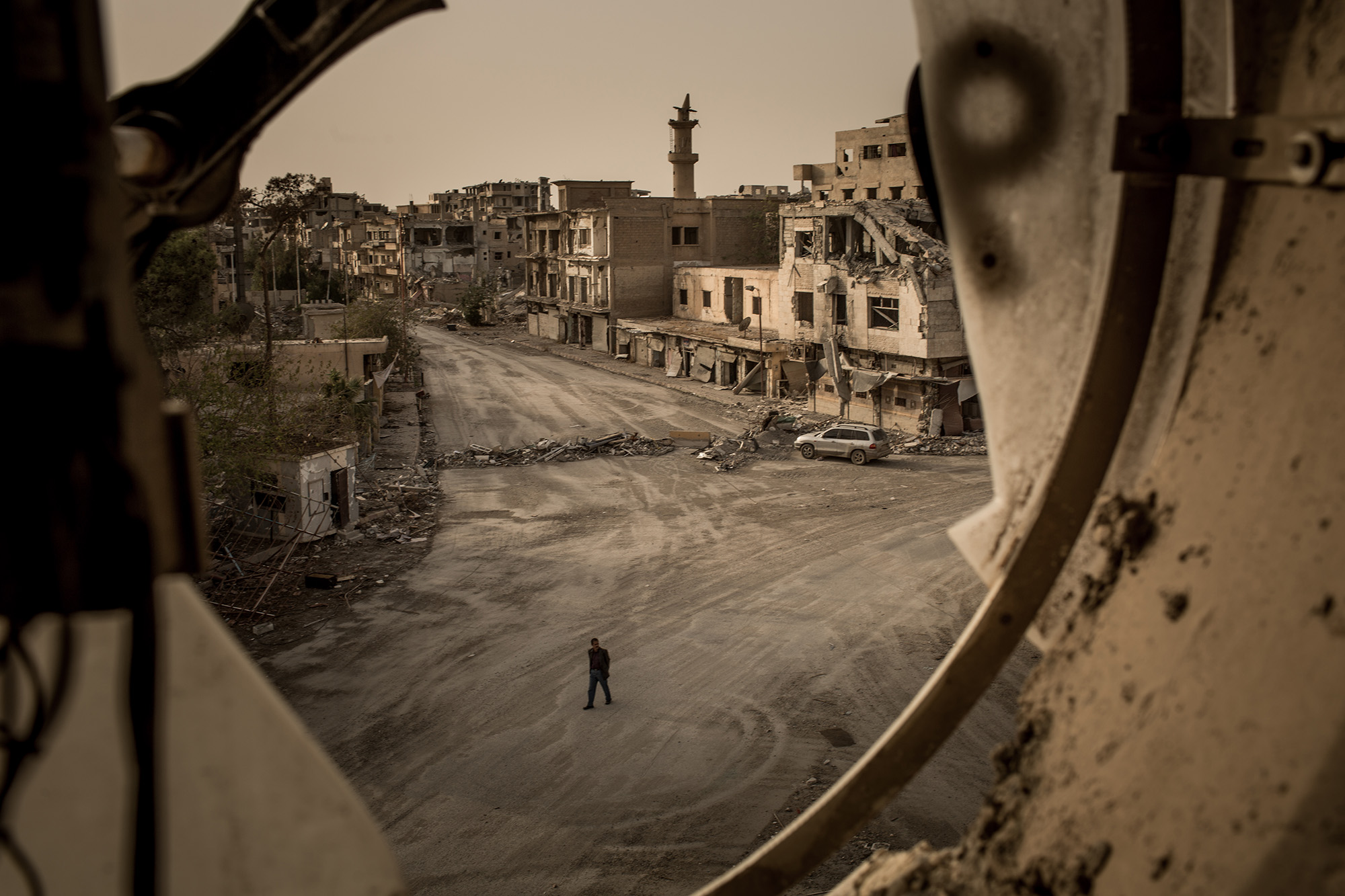
“Are you sure?”
“Yeah, but I’m a journalist.”
“Okay, I don’t care if you are a journalist. You don’t take pictures of my motorcade. Period.”
“I’m an American,” I say. “I am free to take pictures of American forces.”
“Okay, buddy.” He marches back to his vehicle and gets in, and the three SUVs drive away into a warren of bombed-out buildings and mounds of rubble.
Raqqa is an apocalyptic landscape of dust and debris. I visited Baghdad and Fallujah during the Iraq War, and they looked nothing like this. Even Syrian cities that have seen heavy fighting, like Deir Ezzor and Aleppo, are less damaged. By early 2018, as much as 80 percent of the city’s buildings had been destroyed or damaged, according to the United Nations. Amnesty International has called Raqqa “the most destroyed city in modern times.” Light posts lean over roads flanked by giant knots of metal and concrete. Blankets, clothing, and neatly piled unexploded mortars are visible inside buildings that no longer have walls. In the dark skeleton of an apartment complex, two men struggle to adjust rebar with their bare hands. Much of Raqqa’s population fled during the fighting; more than 150,000 people have returned since ISIS was driven out, according to the United Nations.
At a desolate roundabout, an old man sells lighters and water bottles full of gasoline. “ISIS used to hang human heads here,” he tells me. “They would crucify people, shoot them in the head, and leave them for 24 hours. There used to be restaurants all around the square, and people would eat sandwiches and drink fruit cocktails. When they finished they would go spit on the heads.” Then the coalition jets came. “They didn’t just try to get rid of ISIS. They tried to destroy everything so [ISIS] had nowhere left to stay.”
When the revolt against Assad began in 2011, the protests in Raqqa were small. The government was so confident of its hold on the city that the president visited in November 2011 to attend a large public prayer. In March 2013, jihadist groups including Jabhat al-Nusra joined forces with Free Syrian Army factions and pushed government officials and security forces out of Raqqa, making it the first provincial capital to be “liberated.” Anti-Assad activists flocked to the city and used it as a base. “Life was coming back to the city,” Mezar Matar, a secular opposition activist, tells me. “Unlike other areas, there was electricity and water. There were restaurants and cafés.”
The secular activists and the jihadists left each other alone at first, but eventually Nusra tried to take control. The activists protested Nusra’s public executions of suspected “Alawite officers” and the kidnapping of opposition members. It was the first time secular activists found themselves living under Islamist rule, but it was nothing like what would come under ISIS. “Nusra didn’t try to repress the protests,” Matar says. “They let us march.”
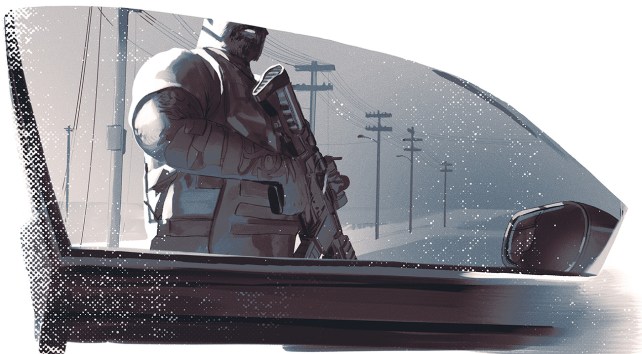
“You don’t take pictures of my motorcade,” the special forces operative tells me.
Owen Freeman
ISIS split from Nusra in April 2013. For a while, different groups controlled different parts of Raqqa, but in January 2014, ISIS fighters completely took over the city. That June, the Islamic State declared the creation of its caliphate, with Raqqa as the capital.
Syrian, Russian, and American jets bombed Raqqa throughout most of ISIS’s reign. But the real battle for the city began on June 6, 2017, when the US-led coalition launched its largest assault ever. Over the next four months, there were more than 4,000 air and artillery strikes on the city, 95 percent of them conducted by American forces. US Marines launched 30,000 artillery rounds into the city, more than any Marine battalion had fired since the Vietnam War, according to a Pentagon official. (The barrage was so intense that the barrels of two howitzers melted.)
The pulverization of Raqqa came after an aggressive escalation of the US war in Syria under President Donald Trump. After he took office, the military shifted to what then–Defense Secretary James Mattis called “annihilation tactics” in its ongoing fight against ISIS. “I totally changed the rules of engagement,” Trump boasted in October 2017. During his first year in office, the coalition launched nearly 40,000 munitions from aircraft in Iraq and Syria, almost 10 times the amount fired by US forces in Afghanistan that year. The number of coalition air and artillery strikes in Syria increased 161 percent compared to 2016, and the number of civilian deaths quadrupled, according to the watchdog group Airwars. The coalition admits to having unintentionally killed 1,291 civilians in Iraq and Syria between August 2014 and March 2019; Airwars counted between 2,700 and 4,300 confirmed or reported civilian deaths from coalition airstrikes in Syria in 2017 alone. (Overall, the coalition is estimated to have killed at least 7,800 civilians. In comparison, Airwars estimates that Russian forces have killed at least 3,300 civilians since 2015.)
The unprecedented death toll “suggested in part that policies aimed at protecting civilians had been scaled back under the new administration,” wrote Alex Hopkins, an Airwars analyst. The coalition admits to having killed 180 civilians in the battle of Raqqa in 2017. A recent investigation by Amnesty International and Airwars puts the number at more than 1,600; local first responders estimate it to be even higher. The SDF, meanwhile, lost about 650 fighters in the battle. “We had to get [ISIS] out of Raqqa,” says Brett McGurk, the presidential envoy to the anti-ISIS coalition at the time. “We did it without costing any American lives. It all kind of went according to plan.”
I came to Raqqa to see the aftermath of the most intense US assault in Syria and the human cost of our war against ISIS.
At an intersection on the edge of town, I meet a man I’ll call Wael, whom I’ve hired to help me get around the city. In a crisp suit, tie, and clean leather shoes, he stands out against the dusty landscape. We get in his truck and he puts Celine Dion on the stereo.
Wael is a religious man, more so than most Syrians. When ISIS first took over the city, he would challenge its members on their interpretation of Islam. In particular, Wael took issue with the fact that ISIS didn’t source its jurisprudence from the Quran or the sayings of the Prophet Muhammad, but from Ibn Taymiyyah, a controversial 13th-century scholar who had justified jihad against other Muslims. At one point, an ISIS sheikh invited Wael to have a private debate about their differing readings of Islamic law. “I wasn’t worried because I had Shariah evidence for my arguments,” Wael tells me.
Their discussion was amicable, but a few days later, Wael was arrested. The sheikh had secretly recorded their conversation and used it as evidence of Wael’s apostasy. ISIS police took him to prison, where they tortured him and told him they were going to kill him. “They thought I was Satan trying to lead them astray,” he says. Wael told them he had been naive and vowed to follow their guidance. They let him go, but he soon got in trouble while doing research at an internet café on a Saudi scholar who opposed suicide bombings. ISIS’s religious police, the hasba, searched his tablet, threw him into a van, blindfolded him, and took him to prison. He was soon released.
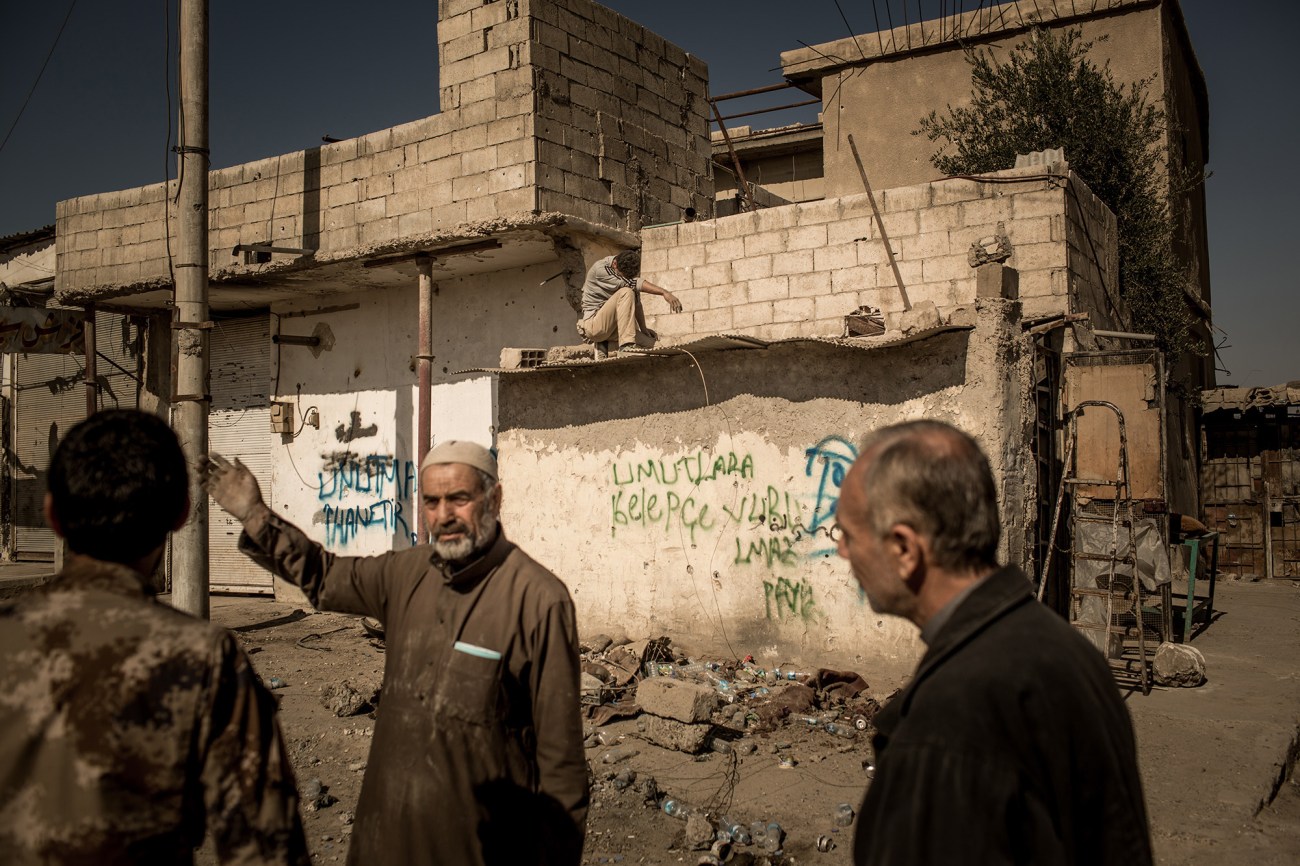
Raqqa, Syria
Christian Werner
The repression became more severe over time. All men were required to pray at a mosque rather than at home. “You didn’t know if you were late for prayer if they would send the hasba after you,” Wael recalls. A friend of his was apprehended for trimming his beard too short; another did time for selling cigarettes.
ISIS’s leadership was mostly made up of foreigners who were concerned less with replacing the Syrian government than establishing an ever-expanding Islamic state. Wael met many of them at the hospital where he worked as an MRI technician. He remembers a Kazakh with needle tracks on his arms who said he had been in the mafia back home. “Ninety percent of these people had no value where they were from,” Wael says. Then they came here and suddenly they had weapons, money, and power.
We drive to Wael’s neighborhood, a network of dirt roads and modest houses surrounded by cement walls. Wael waves to a neighbor sitting on a parked motorcycle. “He used to be in ISIS,” he tells me. “This neighborhood used to be full of them.”
Toward the end of the battle of Raqqa, many residents evacuated the neighborhood. Before ISIS withdrew, it left some deadly surprises for the “apostates” who had abandoned it. When some of Wael’s neighbors came home, they were blown to pieces after opening booby-trapped closets, windows, and refrigerators, or as they stepped on a mined floor tile or lifted a rigged tea kettle. Some of the bombs were triggered by lasers. Some mines even had mines under them so they’d kill anyone trying to defuse them. Men taught themselves how to disable the explosives and made a living clearing houses for returning residents.
When we pull up to Wael’s place, I try to slip into his walled-in yard without anyone noticing. Inside, chunks of concrete are scattered under pomegranate and orange trees. Last year, the coalition bombed his neighbor’s house; ISIS had turned it into a weapons depot. Under a grape arbor, there is a rectangular hole the size of a body. “That was my neighbor,” Wael says. Someone buried him there during the battle. Afterward, his family returned to dig him up.
Wael makes tea and we sit in the only surviving bedroom. I am supposed to leave soon; the SDF requires all journalists to stay in Kobanî, a Kurdish city two hours away. But Wael says I should just stay with him.
“Why aren’t you afraid of having a foreigner in your house?” I ask him.
“If you aren’t afraid, should I be?” he replies.
“I’m a little afraid, to be honest.” It’s hard to believe there are no remnants of ISIS here. Just the other day, an IED exploded on a nearby street. It doesn’t help that there is still no cell reception in the city. I have a satellite phone, but I’m hesitant to turn it on. Journalist Marie Colvin was assassinated by the Syrian government after they tracked her satphone. Thanks to Wael, I’m not completely cut off. He has a small solar panel that charges a car battery, which powers a rig that intercepts the wifi signal from a nearby internet café. With this, we can connect to the outside world for a few hours a day.
He tells me not to worry about ISIS. Any former members who are still around were low-level fighters who joined more out of a need for a job than ideological conviction. ISIS paid competitive salaries and offered extra support for dependents. The members who stayed behind turned themselves in a while ago, Wael says, and the SDF took their guns away. “But if it makes you feel better, we can get guns,” he says.
I chuckle nervously. “If you can get guns, so can they.”
“Look, protection comes from God,” he says. “Don’t think you are in more danger than me.”
He leaves and goes to Friday prayer at a nearby mosque. I ask him not to tell anyone that an American is staying with him.
While he is away, someone knocks on the gate of his compound. I reflexively look for an escape route. I could climb onto the caved-in roof of one of the rooms collapsed by an airstrike. From there, I could hop over the wall, but I am not wearing shoes. There is more knocking. I go into the tiny bathroom until it stops.
A friend of Wael’s takes us to an empty school whose hallways are packed to the ceiling with dirt. A couple of boys take us out to the back of the building, where there’s a hole in the ground. They’ve been inside it, they tell us, and we follow them in.
ISIS fighters had dug tunnels throughout the neighborhood so they could hide from planes. They dug at night and hid the dirt in large buildings like this to avoid drawing the attention of American drones. The work looks professional, done with power tools and reinforced by metal supports. “They could walk comfortably in here!” Wael’s friend says as we walk through the corridor. “The devils.”
Other tunnels break off to the side. One ends in the living room of a house. There is still a subterranean network beneath Raqqa. When I ask residents about the tunnels, some repeat rumors about hearing voices underground or seeing bearded men emerge from the tunnels. It’s hard for some people to believe that something that had ruled their lives so thoroughly could just be gone, that it won’t reemerge one day. Wael says he thought he was going to be living with ISIS for the rest of his life.
As we drive through the city, we pass a monument painted with the words “No Border, No Nation.” There is an anarcho-syndicalist flag painted next to it, the mark of foreign YPG fighters. Wael asks what it means, and I try to explain what anarchism is. He looks bewildered. “If they were looking for somewhere without government, they came to the right place,” he says.
Wael pulls over and asks a man if he knows whether anyone has been in the tunnel in the Black Stadium. The man says he’s not sure, but he says he spent 48 days imprisoned there in 2015. It’s the same place where Samantha Elhassani told me she was held and tortured. The man, whom I’ll call Zayn, joins us. He says ISIS accused him of killing one of its men. He was released two and a half years ago, but “even when you got out, you still felt like you were in prison. There was no way to escape them. You couldn’t trust anyone, not even your own brother.”
The stadium gates are open and no one is guarding them, so we drive inside. SDF flags hanging from the floodlights flutter in the breeze. Under the stands, a short flight of stairs leads to a long hallway. Bullet casings are strewn across the floor, and a human-sized patch of dust has turned blood red. Wael leads the way to a dark room whose walls are reinforced with sandbags. In the middle of the floor, there’s a wide hole. Wael shines his phone’s light into it. It is 20 feet deep, and there is a tunnel at the bottom.
“There are probably bigger rooms in there,” he says. “Even bedrooms and offices.”
“We’re not going in there,” I say.
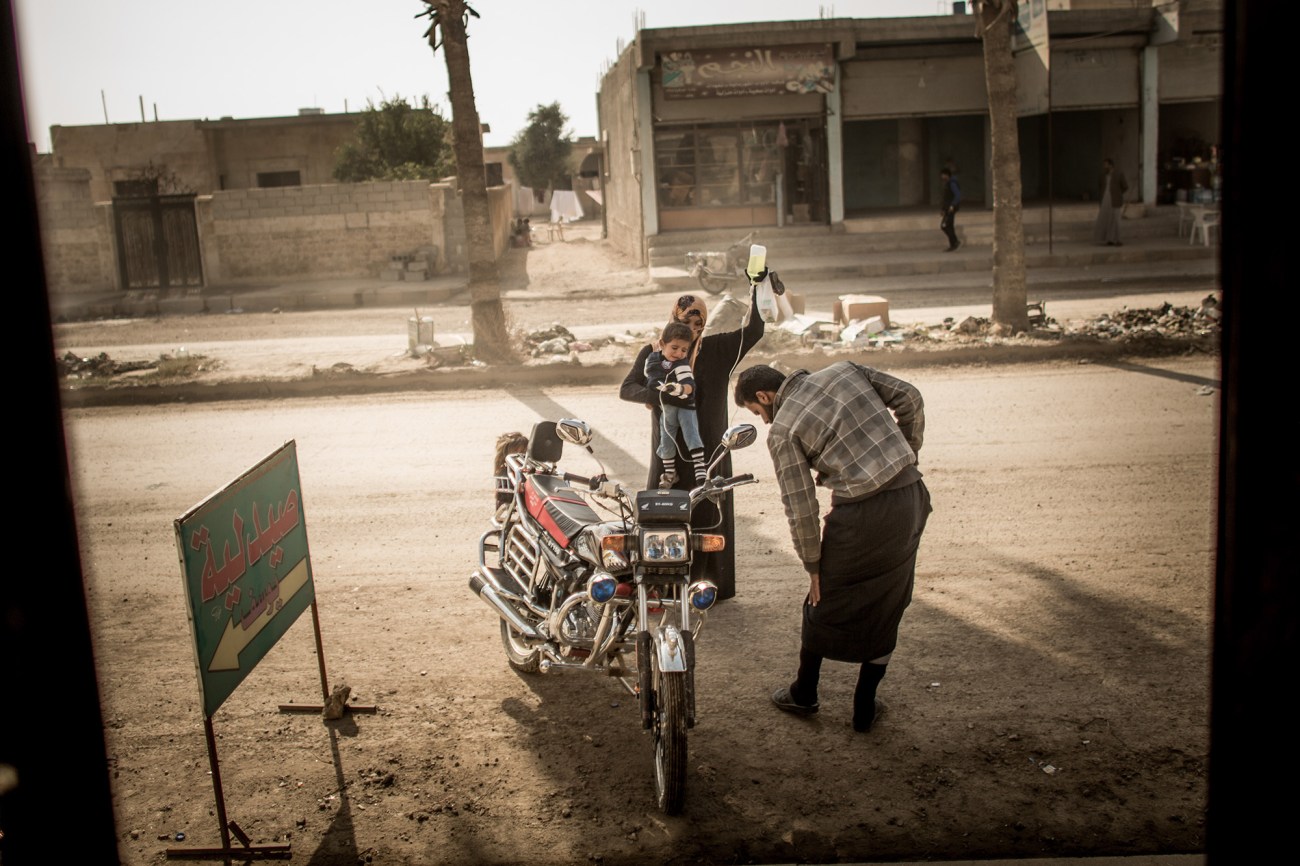
Raqqa, Syria
Christian Werner
We walk down the hall. Other rooms have tiny cells built into them, barely long enough to lie down in. Zayn says ISIS would put up to four men in each one. When I shine a light inside them, I see tick marks on the walls and scribbles in Arabic, Cyrillic, and Latin scripts. “My heart is aching,” one message in Uzbek says. “My soul is staying here and part of my body is staying here. Dear God, I am leaving my husband in your hands…Please God bring us together soon.” “Praise the Caliphate,” reads one message. Another says “I ♥ Sharia.” One cell has crude drawings of a handgun, a grenade, and a suicide belt with “victory or martyrdom” written on it.
I’m surprised that so much of the graffiti is pro-ISIS. When Zayn was locked up, prisoners received long daily religious lessons. ISIS also showed the prisoners battle videos and discussed war strategy. “I knew several people who went in for something small,” Zayn says. “They went through interrogation, became completely brainwashed, and came out extremists.”
We enter a room filled with cagelike cells, like the ones Samantha described. This is where people accused of collaborating with the coalition were held, Zayn says. He points to a pile of rubble next to a huge hole in the wall. “That was my cell,” he says. For two weeks, his captors didn’t speak to him. Masked men would come, open the little window on the cell door, order the prisoners to face the wall, and leave food on the floor. Other times, they would come and take one of his cellmates. “We wouldn’t know if he was coming back, getting out, returning to his family, or going to die.”
Zayn had been careful about what he said to his cellmates; ISIS sometimes sent in spies disguised as prisoners. Eventually, the guards started to take him, blindfolded, for interrogation by a Tunisian whose voice sounded like a boy’s.
Zayn notices a handcuff hanging from a barred door and puts it around his scarred wrist. His captors would cuff him from behind, he says, then string him up by the wrists until his arms contorted backward and his toes were barely on the ground. “They might leave you for a half hour; they might leave you for two days,” he says. “Even if a person didn’t do anything, he will talk. He will admit to doing something he didn’t do so they let him down.” He walks around the room. “There were people who lost their minds completely,” he says.
“I asked to join them so they would let me out of prison. I said that I want to kill in the name of God, that I would blow myself up for them.” Eventually, ISIS let him go. “For the two years after I got out of prison, I cut off all relations with the world. I would go from my house to work, saying hello to people along the way and that’s it. I didn’t even talk to my relatives.”
We go outside and sit on the bleachers. “I used to come and watch games here,” Zayn says. “Those were my best days.” Across the soccer pitch is some graffiti in Turkish, presumably scrawled after the YPG’s Kurdish fighters took over. “The forces of freedom are in Raqqa,” it says. “Now it’s Turkey’s turn. We will crush Turkey’s fascism.” In English, the words “Rebel County Drunk Punx” are painted on a wall.
A lone man jogs around the track circling the field. There is a deep thud from an explosion in the distance, but no one reacts. Zayn reminds me not to use his name or show his face in any of the video I shot. “I’m not joking,” he says. “They aren’t here now, but there might be others later who take their place. I’m still afraid of them. There are things I cannot forget.”
On another day, Wael and I walk through a former ISIS building we’ve been told is clear of mines. Papers are scattered across the floor, including stationery with the heading “The Islamic State of Iraq and Syria Center for Education.” Some documents look like relicensing exams for teachers. Questions include “Who is the caliph of the Muslims?” Another document asks:
What is the punishment for the following cases?
- Those who leave the caliphate for the lands of the infidels
- Those who say Shariah is righteous but not suitable for the modern age
- Those who wear the clothing of infidels
- Those who say that Bashar [al-Assad] is a good person, but the problem is those he is surrounded by
The written answers to another exam state that theft should be punished by cutting off a hand, sex out of wedlock is punishable by whipping, and adultery is punishable by stoning to death.
When ISIS took over Raqqa in 2014, it closed the schools immediately, saying they were tools of indoctrination for the regime. Before the civil war, education emphasized obedience to authority and the state. Militarism was embedded in the curriculum, and children received basic combat training. Students who disagreed with teachers were beaten or whipped on their feet. Children memorized speeches by the president and gave Roman salutes while pledging loyalty to him. They were taught that Syria was an Arab nation, Israel was its enemy, and the Kurds were not part of the picture.
Under ISIS, most children stayed home or worked to support their families. Kids caught studying biology were whipped for learning “polytheist science,” then forced to take Shariah courses. Boys were conscripted and sent to training camps as “lion cubs of the caliphate,” where they learned how to use weapons.
Wael and I visit a school that reopened a few months earlier. A couple hundred children shout over each other as they leave class. The jacket of one girl’s schoolbook displays a cartoon warning about the dangers of unexploded ordnance. The administrators have tried as much as possible to return things to normal. The hallways have been pockmarked by bullets and shrapnel, but one wall has been painted with a hot air balloon, trees, and large ABCs. Children’s drawings hang on another wall. “We told them to draw what was on their mind,” one of the teachers tells me. One drawing shows a teddy bear under a bright sun. Another is of girls in pink dresses lying in the grass. Then there is a group of stick people squirting blood, missing limbs and heads, and simultaneously being shot by ISIS fighters and bombed by a plane. There are drawings of heads hanging from trees and posts. There are jets blowing up homes and gardens and ambulances.
Nearby, a young man in a hard hat and a blue jumpsuit looks out over the school’s courtyard. “The first thing [that coalition jets] targeted were the ambulances, fire trucks, and first responders,” he tells me. “They hit the public services institutions, water pumps, and electricity stations. Then they bombed and besieged the city for six months.” Near the basketball court, there is a pile of charred and rusted ambulances. The man in the hard hat—I’ll call him Hamed—was a first responder during ISIS’s reign. When buildings were struck by coalition jets, he and his team would race to rescue people trapped in the rubble. At the end of the day, Hamed says, they would park their ambulances under trees so American planes wouldn’t blow them up. (An American coalition spokesperson told me that the laws of war allow for targeting any object that “makes an effective contribution to military action,” and that “normally protected structures” like mosques and hospitals may be attacked if “they are misused by the enemy for a military purpose.”)
In an attempt to clear the city before the battle, the coalition dropped leaflets warning civilians to leave, but many people couldn’t get out. Wael remembers ISIS fighters forcing some refugees to burn their own cars. During the final stages of battle, ISIS forced civilians back into the city so their presence would frustrate the coalition’s targeting. “They were betting on the morals of the Americans,” Wael says.
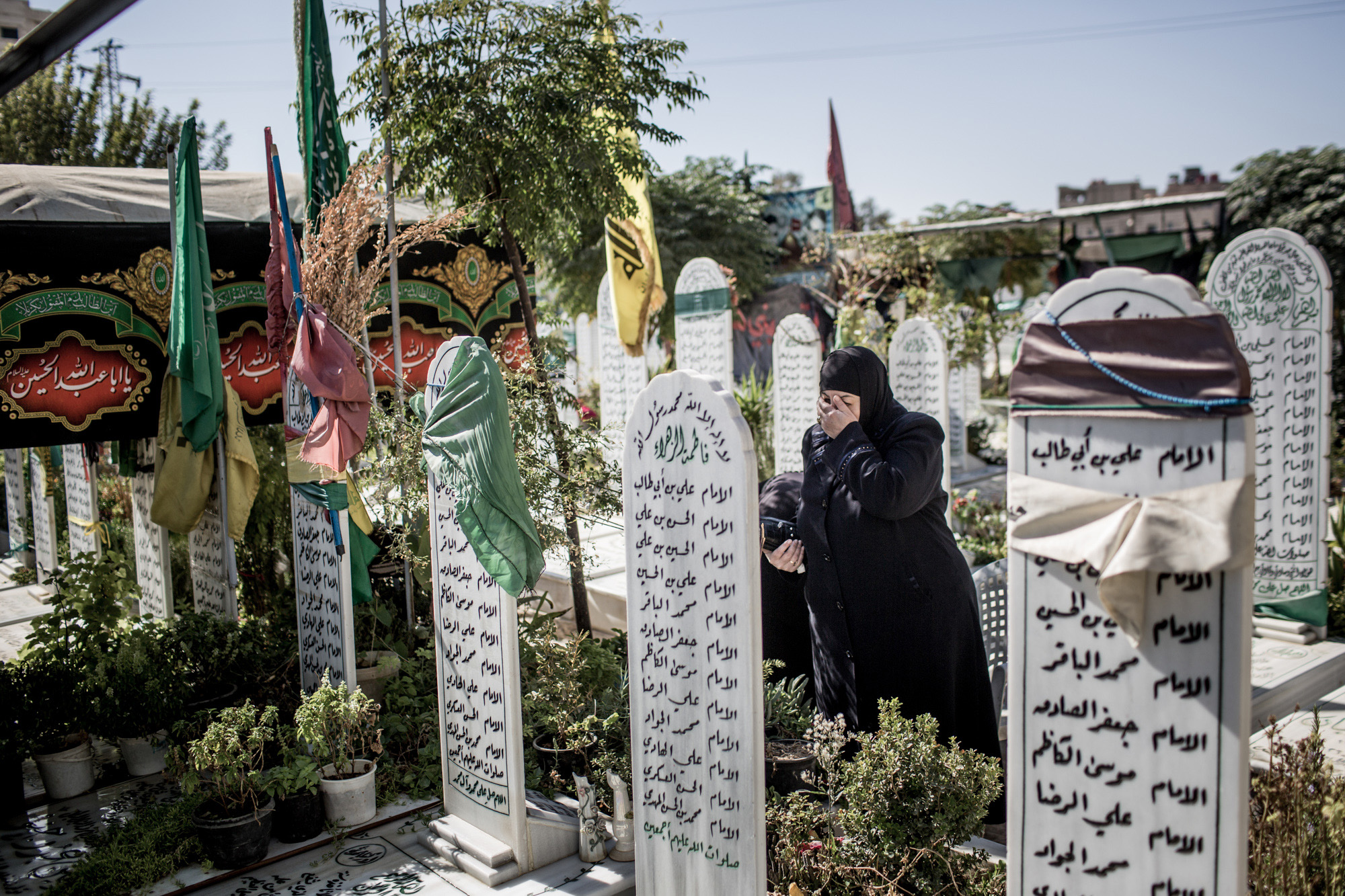
The American military has pushed back vigorously against accounts of excessive civilian casualties in Raqqa. “I challenge anyone to find a more precise air campaign in the history of warfare,” former coalition commander Lt. General Stephen J. Townsend wrote in September 2017, shortly before the campaign ended. “We apply rigorous standards to our targeting process and take extraordinary efforts to protect non-combatants.”
Yet on the ground, there is little indication that the coalition was held back by the presence of civilians. “The coalition bombed everything,” Hamed says. “If a building had one ISIS sniper in it and 50 civilians, they would bomb the building to get the sniper.” To make a building collapse, he says, jets would strike the ground floor multiple times. He points to a collapsed building near the school. “We heard people screaming there for four days after. There was nothing we could do to get them out.”
Even when the responders could pull survivors from the rubble, there wasn’t much that doctors at the hospital could do to help. Hamed says there wasn’t a secure humanitarian corridor for aid to get in or for civilians to get out. “Most people who were injured died. There was nothing we could do but amputate,” he says. (“The coalition takes all reasonable measures to minimize civilian casualties,” its spokesperson told me, adding that the coalition provided an opportunity for “those still in Raqqa to escape” and helped provide aid to those who got out.)
Seven months after the city was taken from ISIS, Hamed is still recovering corpses. Today, the civil council’s First Responders Team is digging in a park near the school. When the children leave to go home, a boy shouts to Hamed. “Did you find the body over there?” he asks, pointing to a corner of the park. “There is a smell.” The men have been digging in another section, where they uncover a skeleton wrapped in a blanket, its limbs in various stages of decay. Based on the uniform, one of the team’s doctors notes that the corpse was an ISIS fighter and the puncture in his skull indicates he was most likely killed by a shrapnel wound.
Just 16 men are responsible for retrieving bodies throughout the city. The director of the First Responders Team, Yasir Khamis, shows me its logbook. There are records of each body found, its location, what the person was wearing, and what the presumed cause of death was. He says the team has recovered 750 bodies over the past five months; about half were civilians. He estimates there are 4,000 or 5,000 remaining. The team rarely has access to bulldozers or excavators, so it works mostly with shovels and picks, which means bodies inside the large, collapsed buildings stay buried.
One of the team’s doctors tells me that most of the bodies found inside ruined buildings are civilians. The team has discovered nine mass graves so far, most of them dug during the siege. The largest was full of civilians who probably died at the hospital; the team has recovered several hundred bodies from it. Some of the long parallel ditches held only women and children.
At the park, the men put the corpse in a body bag and carry it to the six others they have dug up today. One of the doctors squats and opens a bag that appears to be full of dirt. He grabs a handful and lets little pieces of bone fall from his hand. “It’s the body of a child,” he says. “Maybe a year old. Completely burned.” He stands up and looks at me. “From a chemical agent. Phosphorus.” One of the first responders shows me a video on his phone taken during the coalition campaign. Long scattershot balls of fire trailed by thick white smoke stream down from the sky.
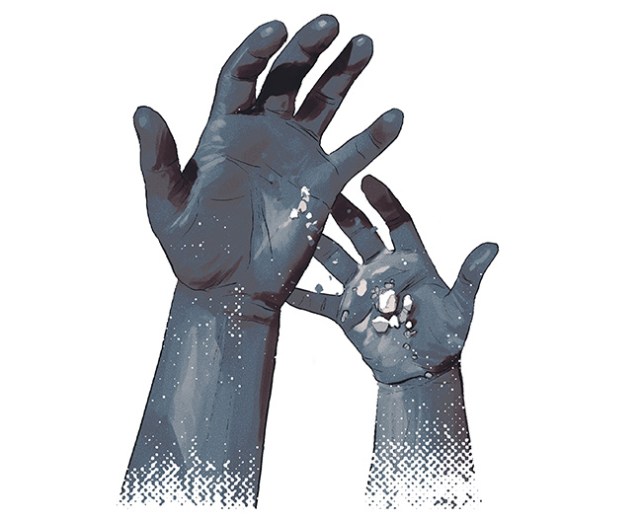
“It’s the body of a child,” the doctor says. “Completely burned.”
Owen Freeman
White phosphorus can be used legally to illuminate the battlefield or as a smoke screen, but because it burns indiscriminately, the United Nations’ 1980 protocol on incendiary weapons prohibits it in areas populated by civilians. When white phosphorus comes in contact with oxygen, it ignites and burns at temperatures up to 1,500 degrees Fahrenheit. It can cause burns down to the bone, and wounds contaminated by white phosphorous can reignite when they’re reexposed to air.
In 2005, journalists uncovered the United States’ deployment of white phosphorus in Fallujah during the Iraq War, our military’s first reported use of the substance since Vietnam. While white phosphorus is considered a conventional weapon when used in accordance with the incendiary weapons protocol, some said the US military had essentially used it as a chemical weapon in Iraq. (When Saddam Hussein was thought to have used white phosphorus against Iraqi Kurdish civilians in 1991, a classified Defense Department document described it as a “chemical weapon.”)
The United States did not ratify the incendiary weapons protocol until 2009, and even then it reserved the right to use white phosphorus against human targets when it’s determined that it would cause fewer casualties than another weapon. The government also specified that any commander who decides to use white phosphorus “shall not be judged on the basis of information that comes to light after the action under review was taken.” The coalition would not confirm to me whether it used white phosphorous in Syria. However, its American spokesperson told me that “every weapons system in the US inventory undergoes a legal review to ensure the weapon complies with the Law of Armed Conflict.”
Hamed shows us around the bombed-out streets of his neighborhood. During the coalition attack, he says, white phosphorus “would fall on us like rain.” The remaining walls on the ground level of his apartment building are blackened from what he says were white phosphorus fires. When he and his neighbors rushed to pour water on the munitions, the flames would reignite. “It was suffocating. You felt like you were going to choke.” He remembers people who were burned to the bone.
His apartment is upstairs. All that’s left is the floor, some cement columns, mounds of rubble, and an unexploded three-foot-long missile. “It was my dream to have a family and kids here,” he says. A small, shy boy who looks to be four years old is following us. The front of his shirt is black with grease. “This is my nephew,” Hamed says. “He works as a car mechanic.” We stand quietly, looking over the charred wreckage and the nearby homes. “Our city was destroyed so that America could sleep soundly.”
When I leave Raqqa, I go back to Qamishli. The de facto Kurdish capital, where I began my journey, now feels like a refuge. There is a loud nightclub across from my hotel. On a nearby rooftop, there is a hookah bar, where I read and write in the warm evenings. I walk through the alleys of a bustling market and eat fresh bread with water buffalo cream and honey. As long as I avoid the tiny part of the city still controlled by the Syrian regime, I feel safe, even when I’m alone.
I’m often with my fixer, a thirtysomething Kurd I’ll call Ibrahim. Under his irreverent, disarming facade and easy smile, Ibrahim is burdened. I rarely see him eat, and when he puts anything in his stomach, he says it hurts badly.
The war has been pressing on him for years. He watched as the FSA and the YPG fought over his hometown. ISIS nearly captured his parents’ village. Ibrahim made repeat trips to the front in Raqqa when he was working as a TV cameraman. He tells me about the traumatic images burned into his mind. Even when there are no bodies around, the smell of the dead follows him. Sometimes, the phantom stench prevents him from eating.
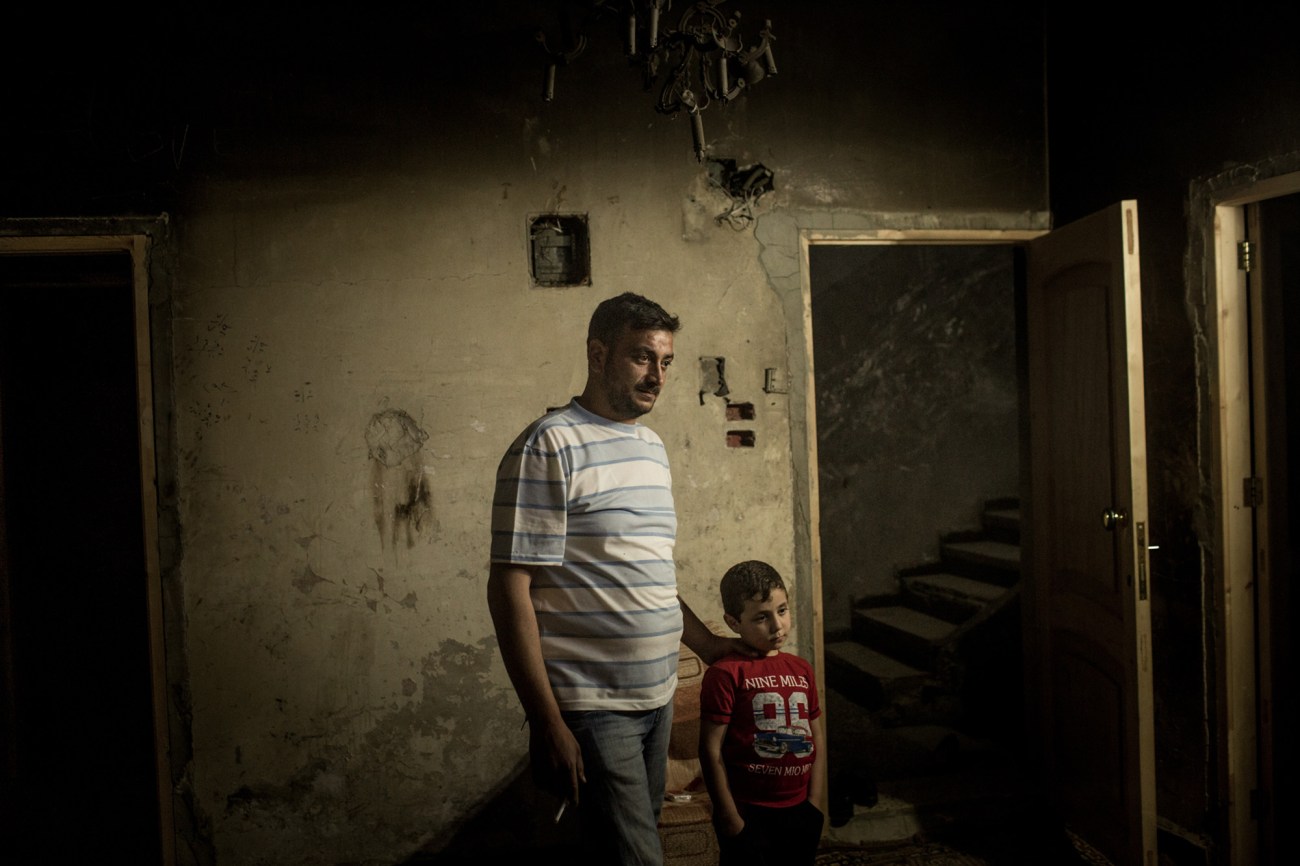
Ayman Beraqdar with his son in the Khalidiya district of Homs
Christian Werner
Ibrahim takes me around to interview Kurdish officials, journalists, and thinkers. Many worry that with the war against ISIS coming to an end, Trump will make good on his recent promise to bring American troops home “very soon.” The Syrian government has vowed to take back every inch of its former territory. Turkish President Erdoğan has threatened to enter northeastern Syria to fight YPG “terrorists” in the event of an American withdrawal. The Turkish invasion of Afrin in 2018 displaced 150,000 people. An attack on the rest of Rojava would certainly be far costlier. Some analysts speculate that the Kurds may defend themselves against Turkey by negotiating the Assad regime’s return to eastern Syria.
There is also the question of what to do with the remnants of ISIS. The de facto foreign minister of the Democratic Federation of Northern Syria, Abdulkarim Omar, tells me one of its “major burdens” is the hundreds of captured ISIS fighters from over 40 countries. The DFNS, he says, does not allow the death penalty. If Turkey invades, what would prevent these prisoners from escaping in the chaos? “We need all of their governments to take them and try them in their countries,” Omar says. And even without its would-be caliphate, ISIS still inspires extremists around the globe.
The war is by no means over, but Assad has undoubtedly won. In eight years, an inspired revolt against a dictator has given way to grudging acceptance that he’s not going anywhere. Syrians are just starting to come to terms with what it means to move forward. Even as the United Nations expects at least 1.2 million people to return home this year, it anticipates that as many as 1.2 million will be displaced. (This spring, a government offensive in Idlib displaced 180,000 people in three weeks; the UN warned that intensified violence in the area would trigger a “humanitarian catastrophe.”) Many who fled will never be able to return. The Assad regime continues to terrorize the population with forced conscription, arrests, and torture. Nearly 128,000 people who entered its prisons are still missing.
As Trump slow-walks withdrawal, it’s not clear what the lasting impact of American involvement in Syria will be. As the war enters its next phase, the commitments made by the many Americans who joined the conflict—the officials and diplomats, the CIA agents and special forces, the ideologues and adventure seekers—may prove fleeting.
As my three-week trip to Syria nears its end, Ibrahim says he will take me to another interview outside town. When he comes to pick me up, he tells me he needs more money than we’d agreed on. His car has broken down. He’s been driving on the home-refined gas that most cars in this area run on. It’s terrible for the engine, and all the driving we’ve been doing has been hard on it. Also, a doctor recently put Ibrahim on psych meds and told him he needs an endoscopy. He tells me the stomach pain got worse after Trump started talking about withdrawal. If Turkey invades, Ibrahim doesn’t know what he will do, or where he and his family will go. And how will they get anywhere without a car?
I tell him I have no way of getting extra cash right now. Can we get to our meeting and discuss it later? No, he says. No money, no ride.
I call a cab and tell Ibrahim we’ll talk when I’m back. Suddenly, he becomes enraged and tries to block my way into the taxi. He grabs my camera bag. A crowd gathers.
“Criminal!” he shouts. “Thief!” I struggle to take my camera from his grip. He punches me in the face. Some men hold him back. “Is this America?” he shouts. “If this is America, you can keep it!” I jump into the taxi and drive off.
Two days later, I leave Syria.
Project Credits
Text
Reported and written by Shane Bauer
Edited by Dave Gilson
Fact-checked by Daniel Costa-Roberts, Rosa Furneaux, and Annie Ma
Fact-check process overseen by Nina Liss-Schultz
Translations by Saphe Shamoun
Design
Visuals by Adam Vieyra, Carolyn Perot, Mark Murrmann
Photos and opener images by Christian Werner
Illustrations by Owen Freeman
UX by Adam Schweigert, Adam Vieyra
Web development by Julia Smith
Maps by Lo Bénichou, Julia Smith
Videos and Podcast
Videos and podcast by Shane Bauer, Mark Helenowski, and James West
Associate producers: Sam Van Pykeren, Jordan Gass-Pooré
Assistant editor and translator: Hany Hawasly
Fact-checked by Daniel Costa-Roberts, Rosa Furneaux, and Annie Ma
